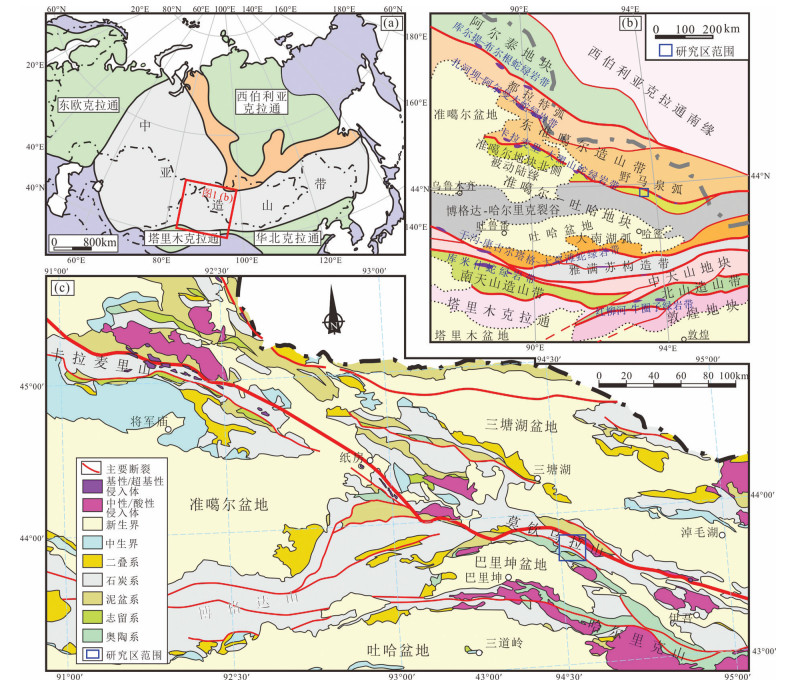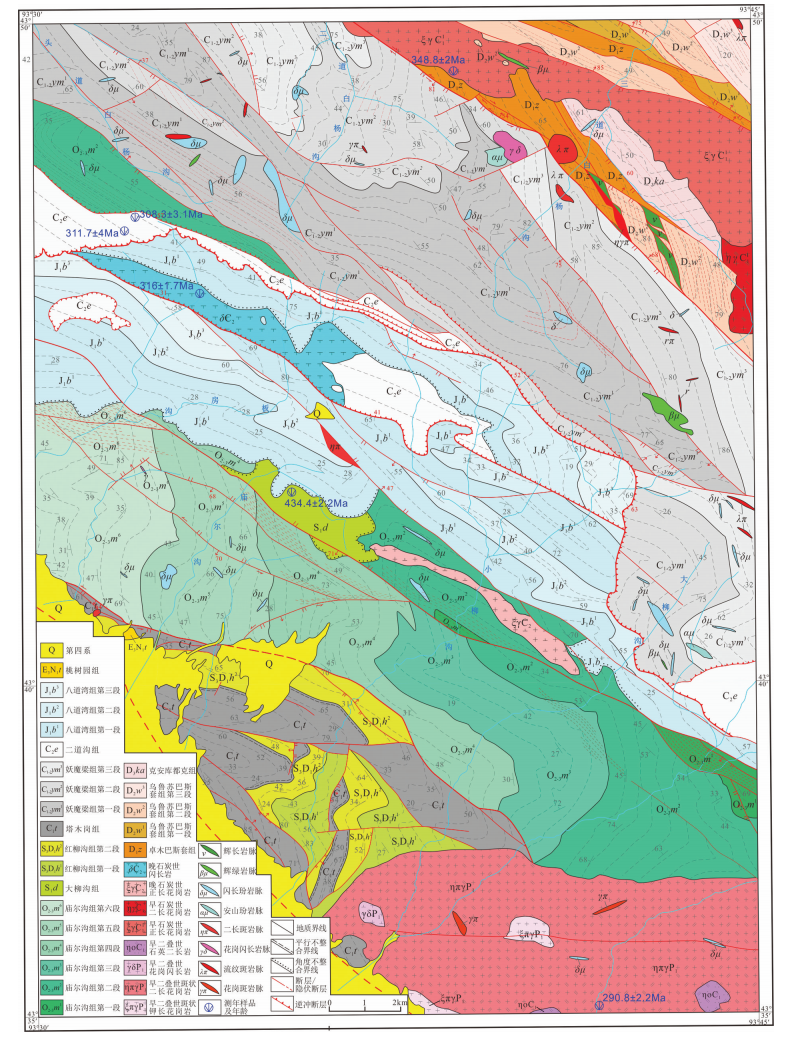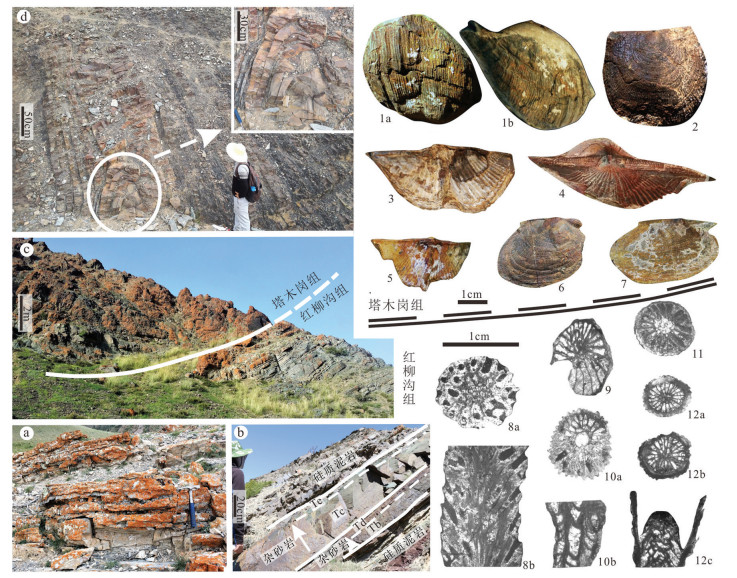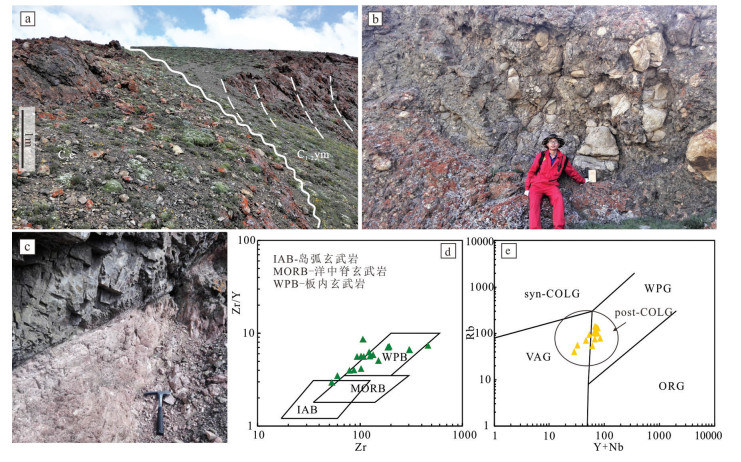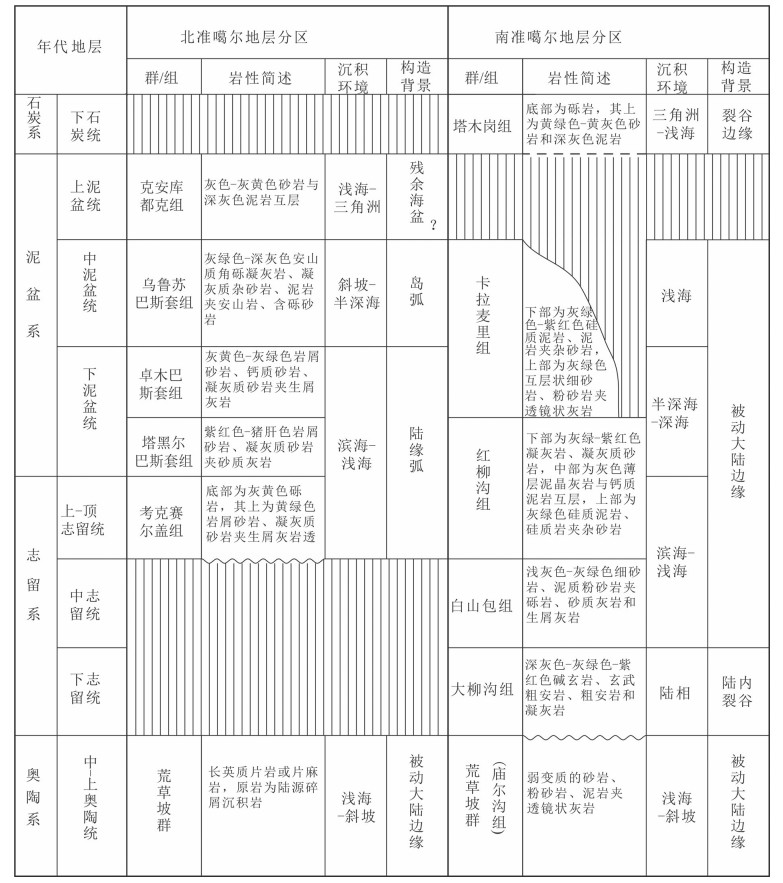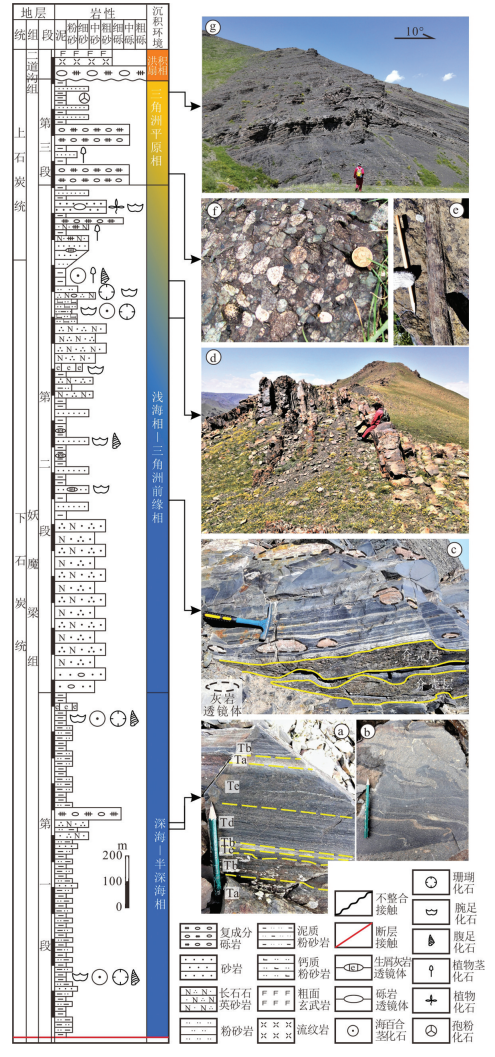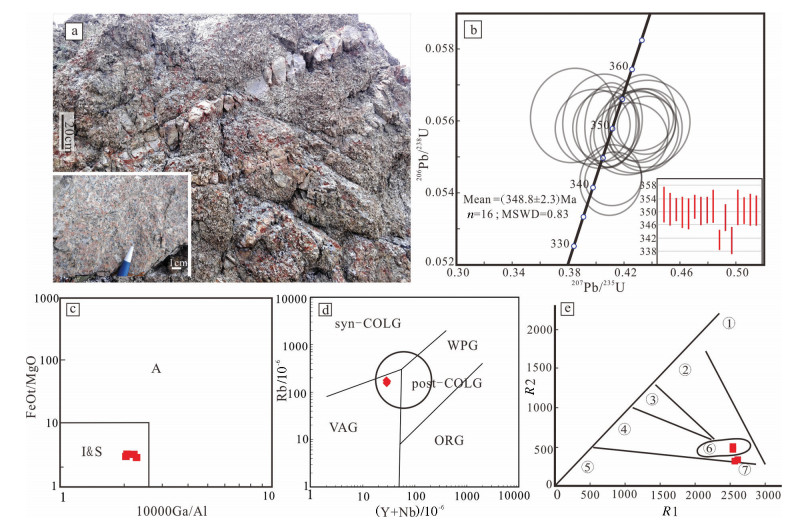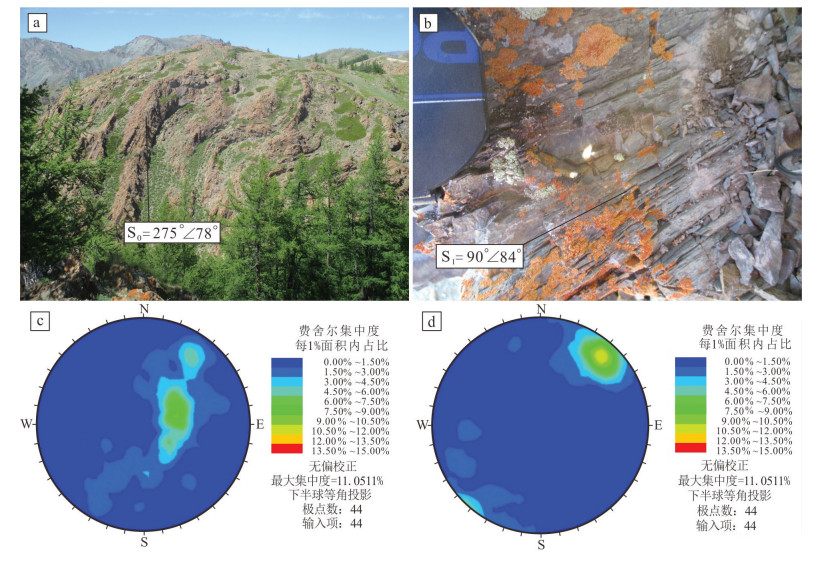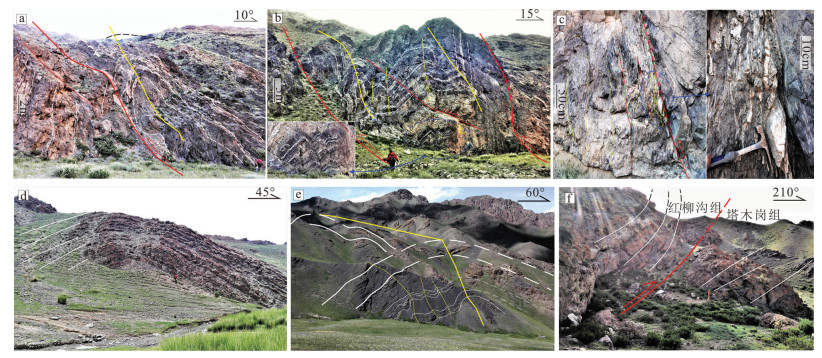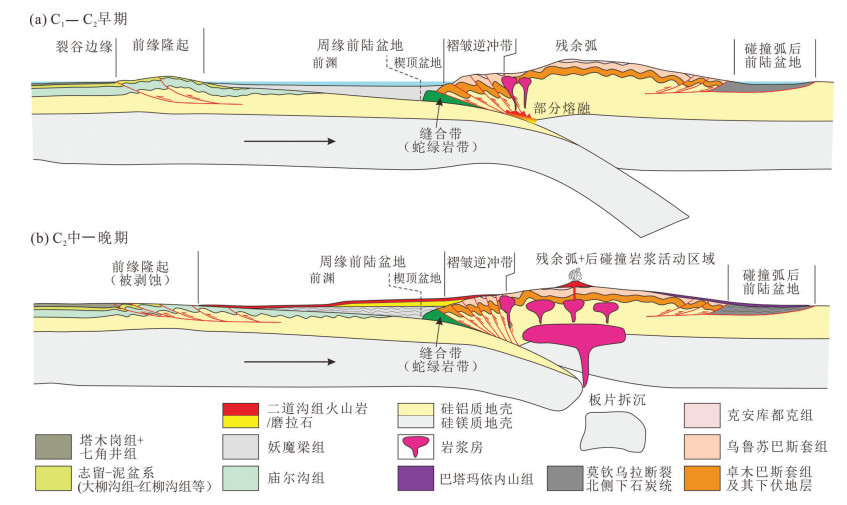Significant Paleozoic tectonic events in the northern part of the East Tianshan Mountains, Xinjiang and their implications for the evolution of CAOB: New evidence from 1: 50000 geological survey of Banfanggou and Xiaoliugou sheets
-
摘要:
本文基于新疆哈密地区1:5万板房沟幅和小柳沟幅区域地质调查新成果,对东天山北部古生代的重大构造事件以及演化历史进行了系统的梳理。基于下志留统与奥陶系之间角度不整合、下石炭统与泥盆系之间平行不整合以及上石炭统二道沟组与下伏岩系之间的角度不整合的确定,揭示奥陶纪与志留纪之交、泥盆纪与石炭纪之交以及晚石炭世期间存在几次重大构造事件。结合古生代不同时期沉积大地构造背景转换、岩浆活动构造环境转换以及构造变形格式转换的地质新纪录,提出奥陶纪与志留纪之交的造山事件为北部阿尔曼太洋闭合导致准噶尔-吐哈地块与阿尔泰地块碰撞的响应;泥盆纪与早石炭世之间的造陆构造事件可能是北部卡拉麦里洋盆初始汇拢碰撞的响应,其平行不整合以及下伏的志留纪-泥盆纪较稳定环境的沉积序列预示着介于卡拉麦里洋盆与南部北天山洋盆之间的准噶尔-吐哈地块为古亚洲洋盆体系中相对刚性的稳定陆块区,研究区作为准噶尔-吐哈地块的北部被动陆缘受卡拉麦里洋盆汇聚的影响较小;晚石炭世的造山事件则表现为响应卡拉麦里洋盆闭合后周缘前陆盆地的演化,是早石炭世沿卡拉麦里缝合带发生陆块碰撞以来挤压构造作用峰期的产物,其奠定了东天山北部北西-南东向构造基本格局。本文还重新界定莫钦乌拉断裂为北天山构造带(准噶尔-吐哈地块)与东准噶尔构造带的构造-地层分区界线,推断其为卡拉麦里缝合带向南东的延伸,并讨论了早石炭世受控不同构造体制的沉积和岩浆纪录的空间差异性,认为早石炭世北部莫钦乌拉山区域为与北侧卡拉麦里洋盆闭合后周缘挤压前陆盆地的发育过程,而南部博格达-哈尔里克山则总体呈现为响应南侧北天山洋盆闭合后的碰撞后伸展裂谷发育过程。
Abstract:Based on the new results of 1:50, 000 geological survey of Banfanggou and Xiaoliugou sheets in Hami area, Xinjiang, this paper systematically reviewed the major tectonic events and evolutionary history during Paleozoic in the northern part of the East Tianshan Mountains. There existed three major tectonic events between Ordovician and Early Silurian, between Devonian and Early Carboniferous and in the Late Carboniferous, respectively, as shown by the newly discovered angular unconformity or disconformity. Combined with a series of new records of sedimentation, magmatism and deformation reflecting tectonic transformation, the links between these tectonic events and the evolution of the Central Asian Orogenic Belt (CAOB) are discussed. It is suggested that the orogenic event that occurred at the turning time from Ordovician to Silurian was the response to collision between the Junggar-Tuha terrane and the Altay terrane following the closure of the Armantai oceanic basin. The disconformity between Devonian and Lower Carboniferous shows an epeirogenic event, probably in response to the initial closure of the Kalamaili oceanic basin to the north. This disconformity and underlying Silurian-Devonian deposits in relatively stable tectonic environment also show that the Junggar-Tuha terrane between the Kalamaili oceanic basin and the North Tianshan oceanic basin was a relatively rigid and stable continental block in the Paleo-Asian Ocean system. The study area, as the northern passive continental margin of the Junggar-Tuha block, was less affected by the convergence of the Kalamaili oceanic basin. The orogenic event in the late Carboniferous was the reflection of peak orogenesis in response to the evolution of the peripheral foreland basin after the arccontinental collision that occurred along the Kalamaili suture zone during late Devonian-early Carboniferous period. This event established the basic NW-SE trending structural framework in the East Tianshan Mountains. The authors also redefined the Moqinwula fault as the southeastern extension of the Kalamaili suture zone, the tectonic-stratigraphic boundary between the North Tianshan Mountains (or Junggar-Tuha block) and the East Junggar terranes, and discussed the spatial differences of tectonic regime in the early Carboniferous. Based on the records of sedimentation and magma of the early Carboniferous, the authors hold that a peripheral foreland basin, which was related to the closure of the Kalamaili oceanic basin, was developed in the Moqinwula Mountain, whereas a rift basin was developed in the Bogda-Harrick Mountain, which was in response to the post-collision extension related to the closure of the North Tianshan Ocean.
-
1. 引言
稀土(Rare earth)是元素周期表中镧系元素和钪、钇共17种金属元素的总称。稀土是重要的自然资源,更是宝贵且关键的战略资源,在民用和军事方面用途十分广泛,同时也是先进装备制造业、新能源、新兴产业等高新技术产业不可或缺的原材料。在全球范围内,稀土资源分布不均,其主要分布于美国、俄罗斯、中国、印度、巴西等国家。中国稀土储量约占世界总储量的23%,却承担了世界90%以上的市场供应(中华人民共和国国务院新闻办公室, 2012)。经半个多世纪的过度开采,中国稀土资源保有储量及保障年限不断下降,鉴于此,发现和利用新类型稀土矿,可有效提高中国稀土资源储量,有力保障国家稀土资源供给安全。
稀土矿床按成因分类主要有碱性岩—碱性超基性岩型、碳酸岩型、花岗岩型、砂矿型以及风化壳型(徐光宪, 1995);按工业类型分类主要有稀土-磁铁矿矿床、含稀土碳酸岩矿床、花岗岩风化壳型稀土矿床、含稀土伟晶岩矿床、含稀土磷块岩矿床以及独居石砂矿床(矿产资源工业要求手册, 2014)。近年来,多位学者报道在贵州威宁地区二叠系宣威组一段黏土岩中富含稀土元素,但是由于该稀土资源的综合利用技术多年来未取得突破(黄训华, 1997; 张震和戴朝辉, 2010; 周灵洁, 2012),稀土元素的赋存状态、富集机理以及稀土矿床成因类型等方面存在较大争议。2018年以来,笔者在滇东—黔西地区开展地质调查,发现研究区内广泛发育的二叠系宣威组富稀土黏土岩系属沉积成因,有别于Wang et al.(2018)提及的南方离子吸附型稀土矿,而类似于文俊等(2021)报道的川南沐川地区宣威组底部古风化壳-沉积型铌、稀土矿,该新类型稀土矿具有矿石禀赋好、矿层厚度大且较连续、“关键稀土元素(Critical rare earth element; Pr, Nd, Tb, Dy)”占比较高等特点,并伴生有铌、锆、镓等有价元素,其中镓的平均品位高达70.5×10-6,高于工业品位(Zhang et al., 2010)。另外,在稀土资源开发利用方面取得了重大突破,针对该稀土资源研发了“选择性浸出”新工艺(徐璐等, 2020),使稀土回收率可达90%以上,该新类型稀土资源有望实现规模化工业利用。滇东—黔西地区沉积型稀土资源的发现与利用,将有力支撑国家关键稀土资源战略储备。
2. 区域地质背景
滇东—黔西地区大地构造位置位于扬子板块西缘(潘桂棠等, 2009),以北西向康定—水城断裂、北东向弥勒—师宗深大断裂带以及近南北向小江断裂所挟持的三角形地带(图 1)。区内地层属华南地层大区的扬子地层区之上扬子地层分区,主体位于黔西北地层小区,部分涉及到云南的昭通地层小区及曲靖地层小区。晚中生代以前主要是海相碳酸盐岩及陆源硅质碎屑岩,以后则主要为陆相沉积。火成岩主要为海西晚期陆相溢流的峨眉山玄武岩及同源异相的浅成侵入岩。
![]() ①—怒江断裂;②—金沙江—红河断裂;③—鲜水河断裂;④—龙门山山前断裂;⑤—小金河断裂;⑥—箐河—程海断裂;⑦—安宁河—绿汁江断裂;⑧—小江断裂;⑨—康定—水城断裂;⑩—弥勒—师宗断裂Figure 1. Sketch map showing geotectonic position of the research area (after Luo Yaonan, 1985; Zhang Zhibin et al., 2006)①-Nujiang fault; ②-Jinsha River—Red River fault; ③-Xian Shui River fault; ④-Longmen Mountain piedmont fault; ⑤-Xiao Jian River fault; ⑥-Jing River—Chenghai fault; ⑦-Anning River—Lü zhi River fault; ⑧-Xiao River fault; ⑨-Kang ding—Shui cheng fault; ⑩-Mile—Shizong fault
①—怒江断裂;②—金沙江—红河断裂;③—鲜水河断裂;④—龙门山山前断裂;⑤—小金河断裂;⑥—箐河—程海断裂;⑦—安宁河—绿汁江断裂;⑧—小江断裂;⑨—康定—水城断裂;⑩—弥勒—师宗断裂Figure 1. Sketch map showing geotectonic position of the research area (after Luo Yaonan, 1985; Zhang Zhibin et al., 2006)①-Nujiang fault; ②-Jinsha River—Red River fault; ③-Xian Shui River fault; ④-Longmen Mountain piedmont fault; ⑤-Xiao Jian River fault; ⑥-Jing River—Chenghai fault; ⑦-Anning River—Lü zhi River fault; ⑧-Xiao River fault; ⑨-Kang ding—Shui cheng fault; ⑩-Mile—Shizong fault3. 测试分析方法
在研究区内采集了186件宣威组一段沉积型稀土矿石样品,正样经破碎研磨至200目,取缩分样50 g/件,送至中国地质科学院矿产综合利用研究所分析测试中心,利用电感耦合等离子体质谱仪(Perkinelmer Optima Nexion 350X)测得稀土配分数据;再取稀土含量(TREO)较高的毛家坪矿点、鱼布沟矿点缩分样20 g/件,送至中国地质科学院矿产综合利用研究所岩石与工艺矿物学研究室,利用X射线衍射仪(日本理学Ultima Ⅳ)测得主要矿物成分。选取稀土含量(TREO)较高的毛家坪矿点、鱼布沟矿点矿石副样,块样用切割机(MecatomeT330)切成3 cm×1 cm×2 cm样品,用环氧树脂镶嵌制光片坯样;松散样经研磨至40目,用环氧树脂镶嵌制砂片坯样。以上坯样用自动磨抛机(EcomeT300)制得直径为3.5 cm圆柱形待测样品,将待测样品送至中国地质科学院矿产综合利用研究所岩石与工艺矿物学研究室,利用英国蔡司(ZEISS)Sigma 500型场发射扫描电镜及配套的德国布鲁克能谱仪(EDS)获取数据,并应用矿物特征自动定量分析软件(AMICS)进行矿物参数全自动定量分析。
4. 稀土资源特征
4.1 富稀土岩系特征
研究区内富稀土岩系发育于二叠系宣威组一段(P3x1)。宣威组出露面积较广(图 2),北至昭通金阳—大关一带,向南经昭通、威宁一直延伸至宣威—六盘水等地,呈北窄南宽的形态展布。宣威组平行不整合于二叠系峨眉山玄武岩组(P2-3em)之上、整合于三叠系东川组(T1dc)之下,是一套乐平世滨岸及湖沼相与同期曲流河相伴生产出的沉积地层,并且多出现在河泛平原背景上,无独立的大型湖泊沉积体系(戴传固, 2017)。
据笔者对威宁县哲觉镇小箐沟(东经103°59′ 08″,北纬26°36′37″)二叠系宣威组一段典型地层剖面(Pm201)研究,查明宣威组一段富稀土岩系主要为灰白色铝土质黏土岩与粉砂质黏土岩互层(图 3a、b),偶见植物碎屑,中部夹砾屑砂岩(图 3f),砾屑呈次圆状,粒度2~4 mm不等,由下往上砾屑粒度表现出粗—细—粗的渐变特征;岩石碎裂呈砂状、松散片状(图 3c),局部可见层理构造;稀土含量较高的岩石主要为铝土质黏土岩(图 3d、e)、粉砂质黏土岩(⑨~⑪层,⑬~⑮层)。
![]() 图 3 贵州威宁哲觉镇宣威组一段(P3x1)剖面-柱状图a—宣威组一段典型剖面;b—宣威组一段柱状图;c、d、e—铝土质黏土岩;f—砾屑砂岩Figure 3. Typical profile and histogram of the first part of Xuanwei Group (P3x1) in the Zhejue town of Weining area, Guizhou Provincea-Typical section of the first part of Xuanwei Group; b-Histogram of the first passage of Xuanwei Group; c, d, e-Bauxitic clay rock; f-Gravel sandstone
图 3 贵州威宁哲觉镇宣威组一段(P3x1)剖面-柱状图a—宣威组一段典型剖面;b—宣威组一段柱状图;c、d、e—铝土质黏土岩;f—砾屑砂岩Figure 3. Typical profile and histogram of the first part of Xuanwei Group (P3x1) in the Zhejue town of Weining area, Guizhou Provincea-Typical section of the first part of Xuanwei Group; b-Histogram of the first passage of Xuanwei Group; c, d, e-Bauxitic clay rock; f-Gravel sandstone4.2 矿石特征
研究区沉积型稀土矿石主要为深灰—灰白色铝土质黏土岩(图 3c、d、e),具微细粒—隐晶质结构、鳞片状、块状构造。据偏光显微镜、X射线衍射仪、扫描电镜(图 4a)、AMICS矿物分析系统等仪器综合测试分析,结果显示矿石由黏土矿物(高岭石≈83%、埃洛石≈2%、伊利石 < 1%、绿泥石 < 1%)、金属氧化物(锐钛矿≈5%、褐铁矿≈1%、磁铁矿 < 1%、水铝石 < 1%)、硅酸盐矿物(石英+蛋白石 < 4%、火山玻璃≈2%)、金属硫化物(黄铁矿≈0.2%)以及其他方解石、针铁矿等微量矿物组成(徐莺等, 2018)。另外,偶见极少量的氟碳铈矿(图 4b)、方铈矿、磷铝铈矿等独立稀土矿物,其总含量 < 0.1%;以及少量锆石、磷灰石、金红石等含稀土元素的非独立稀土矿物,其总含量 < 1%。
4.3 稀土资源潜力
本文作者在研究区内优选二叠系宣威组(P3x)出露较好的区域,通过32个探槽工程、6个剥土工程地表控制及22个钻探工程深部验证,初步查明研究区二叠系宣威组(P3x)一段稀土矿层厚度2~18 m不等,单个矿石样品TREO含量最高为1.6%,圈定三处稀土矿找矿靶区(图 5):
(1)Ⅰ号找矿靶区:该靶区矿体形态呈层状、似层状,圈定一个矿体,矿体倾角26°~31°,矿体厚度2.96~18.92 m,矿体在地表出露较连续,沿走向延伸可达8 km,矿体TREO加权平均品位为0.21%(边界品位:0.18%,下同),该找矿靶区内推断资源量约4万t,矿床规模达小型。
(2)Ⅱ号矿找矿靶区:该靶区矿体形态呈层状、似层状,共圈定出上下两个矿层、三个矿体,矿体倾角12° ~17°,矿体TREO加权平均品位0.23% ~ 0.39%,矿体厚度5.85~9.23 m,其中主矿体沿倾向延伸可达1.6 km,该找矿靶区内推断资源量约25万t,矿床规模达中型,并具有达大型的潜力。
(3)Ⅲ号找矿靶区:该靶区矿体形态呈层状、似层状,共圈定出上下两个矿层、十个矿体,矿体倾角4° ~10°不等,矿体TREO加权平均品位0.18% ~ 0.46%,矿体厚度1.29~2.99 m。其中主矿体在地表出露连续,深部钻探控制也较稳定,沿倾向延伸可达2 km,该找矿靶区内推断资源量约2万t,矿床规模为小型。
综上所述,该区稀土资源规模大,矿体埋藏浅,产状较缓且连续,有利于大规模露天开采。
笔者在研究区内、找矿靶区以外的昭通、鲁甸、威宁炉山—东风—二塘、六盘水大湾、宣威大井等地(图 2),采集了宣威组一段铝土质黏土岩样品,分析结果显示均有稀土矿化异常,十余处稀土TREO品位超0.1%,最高品位0.42%,算数平均品位0.2%,矿体出露厚度2~6 m不等,推测滇东—黔西地区沉积型稀土资源找矿潜力巨大,远景资源量超100万t。
4.4 稀土配分及资源对比
物源区岩石经风化剥蚀形成的碎屑物质再搬运至沉积区沉积成岩,通常沉积岩继承了物源区岩石的稀土配分特征,风化和成岩作用对沉积岩中稀土元素再分配影响不大(Mclennan, 1993),所以稀土可作为一种有效的示踪物质。
在研究区内优选4条宣威组典型剖面(Pm101、Pm104、Pm205、Pm207),逐层采集岩石样品,分别按玄武岩、铁质黏土岩、铝土质黏土岩、黏土质粉砂岩、炭质黏土岩和砾岩进行稀土元素球粒陨石标准化,从稀土配分模式(图 6)可以看出宣威组富稀土岩系中所有样品均与峨眉山玄武岩均具有相对富集轻稀土元素、亏损重稀土元素、呈现右倾模式的特征;不同的是,大部分铁质黏土岩、黏土质粉砂岩与玄武岩具有更加相近的配分模式,即都只表现出轻微的负Eu异常;而铝土质黏土岩层作为主要的含矿层却表现为明显的负Eu异常(田恩源等, 2020)。
![]() 1—玄武岩;2—铁质粉砂质黏土岩;3—铝土质黏土岩;4—炭质粘土岩;5—黏土质粉砂岩;6—砂质砾岩Figure 6. Chondrite-normalized REE patterns of the samples (modifiled from Tian Enyuan et al., 2020; standardized values modifiled from Sun and McDonough, 1989)1-Basalt; 2-Fe-Silty clay rock; 3-Bauxitic clay rock; 4-Carbonaceous clay rock; 5-Clayey siltstone; 6-Sandy conglomerate
1—玄武岩;2—铁质粉砂质黏土岩;3—铝土质黏土岩;4—炭质粘土岩;5—黏土质粉砂岩;6—砂质砾岩Figure 6. Chondrite-normalized REE patterns of the samples (modifiled from Tian Enyuan et al., 2020; standardized values modifiled from Sun and McDonough, 1989)1-Basalt; 2-Fe-Silty clay rock; 3-Bauxitic clay rock; 4-Carbonaceous clay rock; 5-Clayey siltstone; 6-Sandy conglomerate滇东—黔西地区沉积型稀土矿石中关键稀土元素(CREO)高于国内正在开发利用的四川冕宁碳酸岩型、白云鄂博碳酸岩型、山东微山碳酸岩型以及部分南方离子吸附型等大型、超大型稀土矿床,同样也高于国外即将开发利用的美国芒廷帕斯碳酸岩型、格陵兰岛碱性岩型等超大型稀土矿床。另外,该沉积型稀土资源与离子吸附型、古砂矿型稀土矿对比,在矿石品位、资源规模、集中程度、开采方式、环境影响等方面具有较大的优势,其开发前景巨大(图 7a、b)。
表 1 世界典型稀土矿床对比表Table 1. Comparison table of typical rare earth deposits in the world
5. 开发利用潜力
笔者开展该沉积型稀土矿原矿铵盐浸出对比实验,结果表明稀土原矿中仅有少量(< 5%)稀土元素以离子吸附状态赋存于矿石中。通过多轮技术攻关,利用选择性浸出技术控制焙烧温度和焙烧时间,准确破坏稀土矿中高岭石的特定结构,脱去其层状结构中的羟基,变为高活性的偏高岭石,但偏高岭石仍保持了片状的结构特征。焙烧温度低于550℃,高岭石未转化为偏高岭石,稀土无法有效浸出,焙烧温度高于850℃,高岭石结构被完全破坏,硅和铝晶型会发生变化,对稀土元素进行重新包裹,导致稀土元素无法有效浸出,焙烧过程中不使用添加剂避免产生额外的有害废气。该技术通过协同控制焙烧和浸出条件,选择性浸出偏高岭石中的稀土元素,稀土元素浸出率高于90%,同时主要杂质铝、铁、钛和硅浸出率均<5%,有效抑制杂质大量进入富稀土料液。该技术申请了国家发明专利(徐璐等, 2020)。该技术的推广应用,有望使研究区内的稀土资源实现规模化工业利用。
6. 讨论
6.1 成因探讨
滇东—黔西地区稀土矿的成因研究程度不高,且存在较大争议,目前主要有三种观点:一是风化淋滤型,杨瑞东等(2006)、王伟(2008)以及Yang et al.(2008)通过分析稀土含矿层的地球化学特征,认为该矿床属与峨眉山玄武岩有关的风化壳型,峨眉山玄武岩及凝灰岩被强烈风化淋漓形成高岭石黏土岩,母岩中辉石的稀土元素被解析出来,被高岭石颗粒吸附,使稀土富集,形成稀土矿床;葛枝华(2018)同样赞同风化淋滤型稀土的观点,认为玄武岩风化过程实质就是一种脱硅富铝的过程,辉石、长石类矿物强烈分解,铁铝钛等氧化物明显增加,Ca、Na、Mg、K强烈迅速淋失,SiO2的含量不断降低,元素的迁移活动顺序是CaO>MgO>Na2O>SiO2,认为稀土元素通过风化淋滤作用在风化壳中不断富集起来。二是沉积-改造型,张海(2014)认为稀土矿床的形成与母岩的风化作用、沉积成岩作用以及地下流体作用有关,是沉积-再造型稀土矿床;黄训华(1997)、周灵洁(2012)、张海(2014)、吴承泉等(2019)通过稀土物源、地球化学特征分析,认为稀土矿物源不仅是峨眉山玄武岩,还应包括后期喷发的中酸性火成岩,经风化剥蚀后形成富集稀土的玄武岩质、凝灰质及少量长英质碎屑,经水介质搬运至沉积盆地形成高岭石硬质黏土岩,成岩过程中遭受一定程度的热液蚀变,促进稀土元素再富集;三是部分学者通过对比研究二叠纪峨眉山玄武岩及其同期长英质凝灰岩的地球化学特征,认为稀土异常富集与峨眉山玄武岩同期的碱性岩浆活动产生的凝灰岩有关,并接受了后期低温热液改造(Xu et al., 2001; Zhou et al., 2002; Long et al., 2004; Dai et al., 2010; Zhao et al., 2016)。
笔者研究发现,区域上宣威组富稀土岩系整体呈层状产出,从滇东到黔西横向演化和相变特征清晰;富稀土岩系底部常见河道相砾岩,辫状河沉积体系发育,层内偶见植物碎屑化石,层间发育水平层理等典型沉积构造;稀土含量较高的岩石主要为灰白色铝土质黏土岩,矿物组成主要为高岭石以及少量来自玄武岩及凝灰岩的典型矿物;由稀土配分模式看出铁质黏土岩和黏土质粉砂岩与玄武岩相比具有继承性,而铝土质黏土岩呈现出有别于玄武岩的明显负Eu异常特征(田恩源等, 2020);滇东—黔西地区位于上扬子陆块西缘,晚震旦世以来,长期处于相对稳定的台地沉积环境,区内无岩浆活动,不具备热液型稀土及南方离子吸附型稀土的成矿条件。基于以上认识,本文认为峨眉山玄武岩及同期的凝灰岩为富稀土岩系提供了主要的物质来源,而富稀土岩系中铝土质黏土岩很可能在沉积成岩过程中混入了大量上地壳富稀土物源区的物质,使得铝土质黏土岩中稀土异常富集。综上所述,本文认为滇东—黔西地区稀土资源成因类型为沉积型,是一种新类型的稀土资源。
6.2 稀土元素赋存状态
该稀土矿中稀土元素的赋存状态存在较大争议,前人分析矿石中稀土元素含量的高低可能与矿物组分有密切关系(周灵洁, 2012; Zhou et al., 2013; Zhang et al., 2016; Zhao et al., 2016, 2017; He et al., 2018)。在风化过程中,如果含稀土元素的副矿物抗风化能力弱,稀土元素则容易从副矿物中释放出来,以离子形式迁移富集于黏土矿物中,黏土矿物含量越高,稀土含量往往也相应比较高,稀土含量与黏土矿物含量就有较高的正相关性,据此推测认为稀土元素极有可能以离子吸附相和富含稀土元素的残余独立矿物相组成,与高岭石等黏土矿物含量密切相关;徐莺等(2018)利用电子探针、X射线衍射等现代分析测试手段并结合矿石选冶试验,认为稀土元素以类质同象为主、离子吸附相为辅的形式赋存于高岭石质黏土岩中;黄训华(1997)、吴承泉等(2019)通过分析在强烈风化条件下母岩被解析形成的稀土元素可能存在的赋存状态,认为稀土元素可能以离子吸附态、胶体吸附态等的混合态赋存于高岭石硬质黏土岩中。以上研究并未提供确凿证据证明稀土元素赋存状态。本文作者开展多组原矿铵盐浸出对比实验,稀土元素浸出率不超过20%,间接说明了稀土原矿中以离子吸附态赋存的稀土元素占比很低;据矿石岩矿鉴定,查明以独立稀土矿物形式赋存的稀土元素占比<0.1%,以类质同像(非独立稀土矿物)形式赋存的稀土元素占比也很低;而通过550℃~850℃焙烧选择性浸出技术,准确破坏稀土元素载体矿物——高岭石的特定结构,稀土元素浸出率高于90%。基于以上研究,推测稀土元素极有可能以某种形态赋存于高岭石矿物晶体层间间隙中。
6.3 关键稀土元素及其价值
随着全球新材料、新技术、新能源、高新电子、高端装备制造、先进军事装备等战略性产业迅猛发展,加快了对原材料的结构性调整,一批新兴战略性关键矿产成为各国竞相争夺的资源。根据稀土各元素特有的性质,轻稀土中的Pr、Nd,重稀土中的Tb、Dy等元素由于其在高强度永磁行业、新能源汽车产业、高端声光电材料等方面具备不可替代的地位,这些制约着全球新兴产业、高新科技健康发展的稀土元素称之为“关键稀土元素(CREE)”。据上海有色网公布的2020年6月稀土氧化物实时交易均价(据上海有色网未公布Tm2O3、Yb2O3、Lu2O3成交均价)显示(图 8),Pr、Nd、Tb、Dy关键稀土氧化物价格分别29.5万元/t、28.0万元/t、419万元/t、194万元/t,合计约占所有单一稀土氧化物价格总和的88%,可见关键稀土元素具有极高的经济价值和重要的战略地位。
滇东—黔西地区发现的沉积型稀土矿具有矿层厚、矿石品位高、资源潜力大、矿石中关键稀土元素(CREE)占比高等特点,特别是矿石选冶新工艺取得重大突破,使该类型稀土矿可能实现规模化工业利用。该沉积型稀土矿的发现既丰富了全球稀土资源工业类型,又支撑了国家关键稀土资源战略储备。
7. 结论
(1)滇东—黔西地区发育于二叠系宣威组的稀土矿,其成因类型属沉积型。
(2)稀土元素极有可能以某种形式赋存于高岭石矿物晶体层间间隙中。
(3)该沉积型稀土矿具有矿体厚度大、矿石品位高、资源潜力大、开采成本低、矿石中关键稀土元素(CREO)占比高等优点,其开发利用前景较好。
(4)该沉积型稀土资源的发现既丰富了全球稀土资源工业类型,又支撑了国家关键稀土资源战略储备。
致谢: 感谢中国地质调查局授予本文涉及的1:5万板房沟幅“特优图幅”荣誉称号!感谢项目组全体师生在填图工作中的辛勤付出! -
图 1 研究区大地构造位置及区域地质简图
a—中亚造山带地质简图(据Jahn et al., 2004修改); b—新疆北部构造单元分区图(据Xiao et al., 2008修改); c—研究区及邻近地区地质简图
Figure 1. Tectonic setting and regional geological sketch map of the study area
a-Geological sketch map of the Central Asian Orogenic Belt (modified from Jahn et al., 2004); b-Tectonic divisions of northern Xinjiang (modified from Xiao et al., 2008); c-Geological map of the study area and adjacent areas
图 3 大柳沟组火山岩及其与下伏岩系不整合关系和锆石U-Pb年龄
a—大柳沟组玄武岩与下伏庙尔沟组粉砂岩的角度不整合关系; b—大柳沟组渣状熔岩(气孔玄武岩); c—大柳沟组粗安质角砾熔岩锆石U-Pb年龄谐和图(据赵浩等, 2018b)
Figure 3. Volcanic rock of Daliugou Formation and its unconformity with underlying strata and zircon U-Pb age
a-Unconformity between basalt of the Daliugou Formation and siltstone of the Miaoergou Formation; b-Stomatal basalt of the Daliugou Formation; c-Zircon U-Pb concordant diagram of the trachyte-andesitic breccia lava of the Daliugou Formation (after Zhao Hao et al., 2018b)
图 4 红柳沟组和塔木岗组野外现象及其中化石
a—红柳沟组一段薄层灰岩与钙质泥岩互层; b—红柳沟组第二段的硅质泥岩夹凝灰质杂砂岩; c—红柳沟组和塔木岗组的平行不整合接触关系; d—塔木岗组的中层砂岩-薄层泥岩夹粉砂岩沉积,发育巨大的砂岩结核。化石: 1—Linoproductus sp.; 2—Dictyoclostus deruptus quadratus F.M. Zhang; 3~4—Unispirifer sp.; 5—Brachthyrina sp.; 6~7—Limipectecten tianshanensis Yang; 8—Thamnopora sp.; 9—Amsdenoides sp.; 10—Syringaxon bohemicum (Barrande); 11—Barrandeophyllum sp.; 12—Palaeocyathus bohemicus Počta
Figure 4. Field phenomena and fossils of Hongliugou Formation and Tamugang Formation
a-Interbedded thin-layered limestones and calcareous mudstones in the lower part of the Hongliugou Formation; b-Silty mudstones intercalated with tuffaceous greywacke in the middle part of the Hongliugou Formation; c-Parallel unconformity between the Hongliugou Formation and the Tamugang Formation; d-Interbedded middle-layered sandstones and thin-layered mudstone intercalated with siltstones of the Tamugang Formation, with large sandstone nodules observed
图 5 二道沟组火山岩及其与妖魔梁组角度不整合关系和构造环境判别
a—二道沟组地层与下伏地层呈角度不整合接触; b—二道沟组底部的巨砾岩; c—基性火山岩(上)与酸性火山岩(下)互层; d—基性岩Zr/Y-Zr图解(底图据Pearce and Norry, 1979); e—酸性岩Rb-Y+Nb图解(底图据Pearce, 1984), 其中: ORG—大洋脊花岗岩, WPG—板内花岗岩, VAG—火山弧花岗岩, Syn-COLG—同碰撞花岗岩, post—COLG-后碰撞花岗岩
Figure 5. Volcanic rock of Erdaogou Formation and its angular unconformity with underlying Yaomoliang Formation and tectonic setting discrimination
a-Angular unconformity between the Erdaogou Formation and underlying strata; b-Giant conglomerates at the bottom of the Erdaogou Formation; c-Basic volcanic rocks (upper) interbedded with acidic volcanic rocks (lower) in the Erdaogou Formation; d-Zr/Y-Zr diagram of basic rocks of the Erdaogou Formation (after Pearce and Norry, 1979); e-Rb-Y+Nb diagram of acid rocks of the Erdaogou Formation (after Pearce, 1984). ORGOceanic ridge granite, WPG-Intraplate granite, VAG-Volcanic arc granite, syn-COLG-Syn-collision granite, post-COLG-post-collision granite
图 7 莫钦乌拉山妖魔梁一带妖魔梁组地层序列
a—第一段的鲍马序列; b—第一段中火焰状软沉积变形构造; c—第二段中部薄层泥岩与粉砂岩互层,夹介壳层和形态规则的灰岩透镜体; d-第二段上部的中-厚层砂岩与泥岩互层; e—第二段上部的植物茎化石; f—第三段的砾岩; g—第三段上部的泥岩夹粉-细砂岩或两者互层,发育宽缓褶皱,局部可见箱状褶皱
Figure 7. Stratigraphic sequence of the Yaomoliang Formation in the Yaomoliang area, Moqinwula Mountain
a-Bouma sequence in the first section; b-Flame-shaped soft deformation in the first section; c-Thin-layered mudstones interbedded with siltstones, intercalated with shell layers and regular limestone lens in the middle part of the second section; d-Thick-layered sandstones interbedded with mudstones in the upper part of the second section; e-Fossilized plant stems at the top of the second section; f-Conglomerates in the third section; g-Mudstones interbedded with silt-fine sandstones in the upper part of the third section, gentle folds and partially flat topped folds well developed
图 8 莫钦乌拉山早石炭世花岗岩及其锆石U-Pb年龄协和图及构造背景判别图解
a—花岗岩野外露头; b—锆石U-Pb谐和年龄; c—花岗岩类型判别图解; d—花岗岩Rb-(Y+Nb)成因判别图(底图据Pearce, 1984), 其中: ORG—大洋脊花岗岩, WPG-板内花岗岩, VAG—火山弧花岗岩, syn-COLG—同碰撞花岗岩, post—COLG-后碰撞花岗岩; e-花岗岩R1-R2判别图(底图据Batchelor and Bowden, 1985), 其中: ①—幔源花岗岩, ②—板块碰撞前消减地区花岗岩, ③—板块碰撞后隆起花岗岩, ④—晚造山期花岗岩, ⑤—非造山花岗岩, ⑥—地壳熔融的花岗岩(同碰撞), ⑦—造山后期花岗岩. R1=4Si-11(Na+K)-2(Fe+Ti), R2=6Ca+2Mg+Al
Figure 8. Early Carboniferous granite, zircon U-Pb age and tectonic setting discrimination in the Moqinwula Mountain
a-Granite outcrop; b-Zircon U-Pb concordant age; c-Discrimination diagram of granite types; d-Rb-(Y+Nb) discrimination diagram of tectonic setting (after Pearce, 1984); e-R1-R2 discrimination diagram of tectonic setting. ORG-Oceanic ridge granite, WPG-Intraplate granite, VAGVolcanic arc granite, syn-COLG-Syn-collision granite, post-COLG-Post-collision granite. ①-Mantle-derived granite; ②-Subduction related granite before plate collision; ③-Uplifted granite after plate collision; ④-Serorogenic granite; ⑤-Anorogenic granite; ⑥-Crust melting granite (syn-collision), ⑦-Post-orogenic granite. R1=4Si-11(Na+K)-2(Fe+Ti), R2=6Ca+2Mg+Al
图 9 奥陶系庙尔沟组地层南北向构造变形特征
a—南北向层理沿走向的弯曲,反映后期北西-南东向褶皱对早期近南北向构造的叠加; b—平行层理方向的近南北向劈理; c—层理极点的下半球极射赤平投影极密图; d—后期叠加的NW-SE走向的区域性劈理极点的下半球极射赤平投影极密图
Figure 9. NS-trending deformation in the Ordovician Miaoergou Formation
a-Bending along the NS-striking bedding, showing the superimposed fold of late NW-SE trending folds on early NS-trending structures; b-Approximately NS-trending cleavage parallel to the bedding; c-Lower hemisphere stereographic projection of bedding poles; d-Lower hemisphere stereographic projection of late superimposed NW-SE trending cleavage poles
图 10 莫钦乌拉断裂南北两侧志留—石炭纪地层中的北西-南东向构造变形对比
a~c—莫钦乌拉断裂北侧泥盆纪地层中的变形: a—逆冲推覆构造相关的轴面倾向东北的牵引褶皱; b—逆冲推覆相关的牵引褶皱叠加在先期的尖棱褶皱之上; c—高角度逆冲断裂带中发育的S-C面理和构造透镜体; d~e—莫钦乌拉断裂南侧志留—石炭纪地层中的变形:d—红柳沟组中的宽缓褶皱; e—妖魔梁组中的宽缓褶皱,轴面均高角度倾向北东;f—上志留统—下泥盆统红柳沟组逆冲至下石炭统塔木岗组之上,红柳沟组地层发生倒转。图中红色线条代表断层,白色虚线代表地层层理,黄色实线代表褶皱轴面,黄色虚线代表劈理
Figure 10. Deformation comparison in the Silurian-Carboniferous strata between the north side and south side of the Moqinwula fault
a-c-Deformations in the Devonian strata on the north side of the Moqinwula fault: a-Thrust related drag folds with axial plane dipping to the NE; b-Thrust related drag folds superimposed on the earlier angular folds; c-S-C fabric and tectonic lens along the reverse fault; d-e-Deformations in the Silurian-Carboniferous strata on the south side of the Moqinwula fault: d-Gentle folds in the Hongliugou Formation; e-Gentle folds in the Yaomoliang Formation with axial plane dipping to the NE; f- Hongliugou Formation thrusting on the Tamugang Formation with reversed Hongliugou Formation. On the photos, red line=fault, white line=bedding, yellow full line=axial plane and yellow dash line=cleavage
-
Bai Jianke, Chen Juanlu, Tang Zhuo, Zhang Yue. 2018a. The closure time of Junggar Paleozoic oceanic basin:Evidence from Carboniferous detrital zircon U-Pb geochronology in Kalamaili area[J]. Geological Bulletin of China, 37(1):26-38 (in Chinese with English abstract).
Bai Jianke, Chen Juanlu, Zhu Xiaohui, Feng Bo.2018b. Provenance characteristics of Kalamaili Formation in northeastern margin of Junggar Basin:Constraints of geochemistry and detrital zircon UPb geochronology[J]. Earth Science, 43(12):4411-4426(in Chinese with English abstract).
Batchelor R A, Bowden P. 1985. Petrogenetic interpretation of granitoid rock series using multicationic parameters[J]. Chemical Geology, 48(1/4):43-55. doi: 10.1016-0009-2541(85)90034-8/
Buslov M M, Saphonova I Y, Watanabe T, Obut O T, Fujiwara Y, Iwata K, Semakov N N, Sugai Y, Smirnova L V, Kazansky A Y. 2001.Evolution of the Paleo-Asian Ocean (Altai-Sayan Region, Central Asia) and collision of possible Gondwana-derived terranes with the southern marginal part of the Siberian continent[J]. Geosciences Journal, 5(3):203-224. doi: 10.1007/BF02910304
Cai Tuci. 1989. Late Silurian Strata and Tetracoralla in the Barkol region of Xinjiang[J]. Xinjiang Geology, 7(1):67-80 (in Chinese with English abstract)..
Cai Tuci. 1991. Tetracoralla of Early-Middle Devonian epoch in the Barkol region of Xinjiang[J]. Xinjiang Geology, 9(2):138-150 (in Chinese with English abstract). http://en.cnki.com.cn/Article_en/CJFDTotal-XJDI199102003.htm
Cai Tuci, Zhu Qingliang, Sun Qiaoli, He Weidong, Han Xiaoming, Zhang Jiandong, Du Tianxing, Li Jie, Mei Shaowu, Zhang Yuqian, Miao Chanquan, Zhang Yuting, Wang Futang, Du Qing, Qiao Xindong. 1999. Stratigraphy (Lithostratic) of Xinjiang Uygur Autonomous Region[M]. China University of Geosciences Press, Wuhan, 1-430 (in Chinese).
Cai Xiongfei, Fan Guangming, Liao Qun'an, Wang Fuming, Wu Liyun. 2015. Evolution of the Tuvaella fauna in the Silurian Baishanbao Formation of Dongzhun, Xinjiang and its relationship with environment and construction[J]. Acta Palaeontologica Sinica, 54(3):369-380 (in Chinese with English abstract). http://www.wanfangdata.com.cn/details/detail.do?_type=perio&id=gswxb201503007
Cai Xiongfei, Huang Xing, Liao Qun'An, Luo Zhongjie, Fan Guangming. 2018. Discussions on the Final Closure of Karamaili Suture Zone:Constraints from Strata Records of Silurian, Devonian and Early Carboniferous in Karamaili Stratigraphic Minor Region[J]. Geological Review, 64(3):521-542 (in Chinese with English abstract)
Carey S, Sigurdsson H. 1984. A model of volcanogenic sedimentation in marginal basins[J]. Geological Society London Special Publications, 16:37-58. doi: 10.1144/GSL.SP.1984.016.01.04
Chen Xijie, Shu Liangshu, Santosh M, Zhao Xixi. 2013. Island arctype bimodal magmatism in the eastern Tianshan Belt, Northwest China:Geochemistry, zircon U-Pb geochronology and implications for the Paleozoic crustal evolution in Central Asia[J]. Lithos, 168:48-66.
Chen Xijie, Shu Liangshu, Santosh M, Xu Zhiqin. 2014. The provenance and tectonic affinity of the Paleozoic metasedimentary rocks in the Chinese Tianshan belt:New insights from detrital zircon U-Pb geochronology and Hf-isotope analysis[J]. Journal of Asian Earth Sciences, 94:12-27. doi: 10.1016/j.jseaes.2014.07.024
Du Long, Long Xiaoping, Yuan Chao, Zhang Yunying, Huang Zongying, Sun Min, Zhao Guochun, Xiao Wenjiao. 2018. Early Paleozoic dioritic and granitic plutons in the Eastern Tianshan Orogenic Belt, NW China:Constraints on the initiation of a magmatic arc in the southern Central Asian Orogenic Belt[J]. Journal of Asian Earth Sciences, 153:139-153. doi: 10.1016/j.jseaes.2017.03.026
Fan Tingting, Zhou Xiaohu, Gao Jie, Zhao Weibo. 2014. U-Pb Zircon ages of the gabbro in Hongliuxia area of the eastern Junggar and its geological implications[J]. Journal of Xi'an University of Science and Technology, 34(6):707-712 (in Chinese with English abstract). http://www.wanfangdata.com.cn/details/detail.do?_type=perio&id=xakyxyxb201406014
Feng Xiaoqiang, Cui Yubao, Cheng Long, Liu Yumei, Yu Jing. 2016.LA-ICP-MS zircon U-Pb age of gabbro from Aermantai ophiolite in east Junggar, Xinjiang, and its geological significance[J]. Geological Bulletin of China, 35(9):1411-1419(in Chinese with English abstract). http://www.wanfangdata.com.cn/details/detail.do?_type=perio&id=zgqydz201609003
Galewsky J, Silver E A. 1997. Tectonic controls on facies transitions in an oblique collision:The Western Solomon Sea, Papua New Guinea[J]. Geological Society of America Bulletin, 109:1266-1278. doi: 10.1130/0016-7606(1997)109<1266:TCOFTI>2.3.CO;2
Gillespie J, Glorie S, Jepson G, Zhang Z Y, Xiao W J, Danišík M, Collins A S. 2017. Differential exhumation and crustal tilting in the easternmost Tianshan (Xinjiang, China), revealed by lowtemperature thermochronology[J]. Tectonics, 36(10):2142-2158. doi: 10.1002/2017TC004574
Han Yigui, Zhao Guochun. 2018. Final amalgamation of the Tianshan and Junggar orogenic collage in the southwestern Central Asian Orogenic Belt:Constraints on the closure of the Paleo-Asian Ocean[J]. Earth-Science Reviews, 186:129-152. doi: 10.1016/j.earscirev.2017.09.012
Hou Tong, Zhang Zhaochong, Santosh M, Encarnacion John, Zhu Jiang, Luo Wenjuan. 2014. Geochronology and geochemistry of submarine volcanic rocks in the Yamansu iron deposit, Eastern Tianshan Mountains, NW China:Constraints on the metallogenesis[J]. Ore Geology Reviews, 56:487-502. doi: 10.1016/j.oregeorev.2013.03.008
Hu Chaobin, Liao Qun'an, Fan Guangming, Chen Shuai, Wu Weiwei, Tian Jian, Wang Fuming. 2014. Discovery of MOR-type ophiolites from the Dishuiquan region, eastern Junggar[J]. China Science Bulletin, 59(22):2213-2224 (in Chinese with English abstract). doi: 10.1360/N972013-00021
Huang Bo, Fu Dong, Kusky T M, Ruan Kunpeng, Zhou Wenxiao, Zhang Xionghua. 2018. Sedimentary provenance in response to Carboniferous arc-basin evolution of East Junggar and North Tianshan belts in the southwestern Central Asian Orogenic Belt[J]. Tectonophysics, 722:324-341. doi: 10.1016/j.tecto.2017.11.015
Huang Gang, Niu Guangzhi, Wang Xinlu, Guo Jun, Yu Feng. 2013.Formation and emplacement age of Karamaili ophiolite:LA-ICPMS zircon U-Pb age evidence from the diabase and tuff in eastern Junggar, Xinjiang[J]. Geological Bulletin of China, 31(8):1267-1278 (in Chinese with English abstract). http://en.cnki.com.cn/Article_en/CJFDTOTAL-ZQYD201208006.htm
Jahn B M, Wu Fuyuan, Hong Dawei. 2000. Important crustal growth in the Phanerozoic:Isotopic evidence of granitoids from eastcentral Asia[J]. Journal of Earth System Science, 109(1):5-20. doi: 10.1007/BF02719146
Jahn B M, Windley B F, Natal'In B, Dobretsov N. 2004. Phanerozoic continental growth in central Asia-Preface[J]. Journal of Asian Earth Sciences. 23(5):599-603. doi: 10.1016/S1367-9120(03)00124-X
Jiang Hongjun, Han Jinsheng, Chen Huayong, Zheng Yi, Lu Wanjian, Deng Gang, Tan Zhixiong. 2017. Intra-continental back-arc basin inversion and Late Carboniferous magmatism in Eastern Tianshan, NW China:Constraints from the Shaquanzi magmatic suite[J]. Geoscience Frontiers, 8(6):1447-1467. doi: 10.1016/j.gsf.2017.01.008
Jiang Yuxiang, Li Wenliang, Wang Zhe, Feng Jun. 2019. Geochemical characteristic and age characteristics and geological significance of ophiolite in the Kushui ophiolite mélange belt, Hami area[J]. Mineral Exploration, 10(3):445-452 (in Chinese with English abstract).
Li Di, He Dengfa, Santosh M, Tang Jieyun. 2014. Petrogenesis of Late Paleozoic volcanics from the Zhaheba depression, East Junggar:insights into collisional event in an accretionary orogen of Central Asia[J]. Lithos, 184:167-193. https://www.sciencedirect.com/science/article/pii/S0024493713003058
Li Jinyi. 2004. Late Neoproterozoic and Paleozoic Tectonic Framework and Evolution of Eastern Xinjiang, NW China[J]. Geological Review, 50(3):304-322 (in Chinese with English abstract). http://www.wanfangdata.com.cn/details/detail.do?_type=perio&id=dzlp200403015
Li Jinyi, Xiao Xuchang, Tang Yaoqing, Zhao Min, Feng Yimin, Zhu Baoqing. 1988. Research progress of Paleozoic plate tectonics in Karamaili belt, eastern Junggar of Xinjiang[J]. China Science Bulletin, 3:762-764 (in Chinese).
Li Jinyi, Xiao Xuchang, Tang Yaoqing, Zhao Min, Zhu Baoqing, Feng Yimin, 1990. Main characteristics of Late Paleozoic plate tectonics in the southern part of East Junggar, Xinjiang[J]. Geological Review, 36(4):305-316 (in Chinese with English abstract). http://www.wanfangdata.com.cn/details/detail.do?_type=perio&id=dzlp199004003
Li Jinyi, Xiao Xuchang, Chen Wen. 2000a. Late Ordovician continental basement of the eastern Junggar Basin in Xinjiang, NW China:Evidence from the Laojunmiao metamorphic complex on the northeast basin margin[J]. Regional Geology of China, 19(3):297-302 (in Chinese with English abstract).
Li Jinyi, Xiao Xuchang, Chen Wen, Zhang Sihong, Li Weidong. 2000b. Late Carboniferous to Late Triassic thermal evolution of the crust of northern Xinjiang, NW China—40Ar-39Ar dating to Huangcaopo Group in the Kaokesai'ergai Mountain of East Junggar[J]. Acta Geologica Sinica, 74(4):303-312 (in Chinese with English abstract). http://www.wanfangdata.com.cn/details/detail.do?_type=perio&id=dizhixb200004002
Li Jinyi, Yang Tiannan, Li Yaping, Zhu Zhixin. 2009. Geological features of the Karamaili faulting belt, eastern Junggar region, Xinjiang, China and its constraints on the reconstruction of Late Paleozoic ocean-continental framework of the Central Asian region[J]. Geological Bulletin of China, 28(12):1817-1826 (in Chinese with English abstract). http://www.wanfangdata.com.cn/details/detail.do?_type=perio&id=zgqydz200912014
Li Songling, Dong Furong, Feng Xinchang, Li Wenqian. 1999. REE features of ophiolitic suite of Kelameili-Takezhale-Daheishan[J]. Xinjiang Geology, 17(4):356-364 (in Chinese with English abstract). http://www.wanfangdata.com.cn/details/detail.do?_type=perio&id=QK199901089501
Li Wei, Chen Juanlu, Dong Yunpeng, Xu Xueyi, Li Zhipei, Liu Xiaoming, He Dengfeng. 2016. Early Paleozoic subduction of the Paleo-Asian Ocean:Zircon U-Pb geochronological and geochemical evidence from the Kalatag high-Mg andesites, East Tianshan[J]. Acta Petrologica Sinica, 32(2):505-521 (in Chinese with English abstract). http://d.old.wanfangdata.com.cn/Periodical/ysxb98201602016
Li Wenqian, Ma Huadong, Wang Ran, Wang He, Xia Bin. 2008.SHRIMP dating and Nd-Sr isotopic tracing of Kangguertage ophiolite in eastern Tianshan, Xinjiang[J]. Acta Petrologica Sinica, 24(4):773-780 (in Chinese with English abstract). http://www.wanfangdata.com.cn/details/detail.do?_type=perio&id=ysxb98200804016
Li Yongjun, Du Zhigang, Hu Keliang, Li Xinguang, Liu Jing, Zhang Hongrui. 2008. On Disintegration of Qi'eshan Group and Its Definition of Lithostratigraphic Units from Kumutag Sand-Ridge Area in the Eastern Tianshan[J]. Earth Science, 33(4):458-464 (in Chinese with English abstract). http://www.wanfangdata.com.cn/details/detail.do?_type=perio&id=dqkx200804003
Liang Pei, Chen Huayong, Hollings Pete, Wu Chao, Xiao Bing, Bao Zhiwei, Xu Deru. 2016. Geochronology and geochemistry of igneous rocks from the Laoshankou district, north Xinjiang:Implications for the late Paleozoic tectonic evolution and metallogenesis of east Junggar[J]. Lithos, 266:115-132. https://www.sciencedirect.com/science/article/pii/S0024493716302377
Liu Xijun, Xiao Wenjiao, Xu Jifeng, Castillo P, Shi Yu. 2017.Geochemical signature and rock associations of ocean ridgesubduction:Evidence from the Karamaili Paleo-Asian ophiolite in East Junggar, NW China[J]. Gondwana Research, 48:34-49. doi: 10.1016/j.gr.2017.03.010
Liu Yaran, Jian Ping, Zhang Wei, Shi Yuruo, Wang Yizhao, Zhang Luqiao, Liu Dunyi. 2016. Zircon SHRIMP U-Pb dating and O isotope of the Beitashan ophiolitic mélange in the East Junggar, Xinjiang, and its geological significance[J]. Acta Petrologica Sinica, 32(2):537-554 (in Chinese with English abstract). http://d.old.wanfangdata.com.cn/Periodical/ysxb98201602018
Long Xiaoping, Yuan Chao, Sun Min, Safonova I, Xiao Wenjiao, Wang Yujing. 2012. Geochemistry and U-Pb detrital zircon dating of Paleozoic graywackes in East Junggar, NW China:insights into subduction-accretion processes in the southern Central Asian Orogenic Belt[J]. Gondwana Research, 21(2/3):637-653.
Luo Jun, Xiao Wenjiao, Wakabayashi J, Han Chunming, Zhang Ji'en, Wan Bo, Ao Songjian, Zhang Zhiyong, Tian Zhonghua, Song Dongfang, Chen Yichao. 2017. The Zhaheba ophiolite complex in Eastern Junggar (NW China):long lived supra-subduction zone ocean crust formation and its implications for the tectonic evolution in southern Altaids[J]. Gondwana Research, 43:17-40. doi: 10.1016/j.gr.2015.04.004
Luo Ting, Liao Qun'an, Zhang Xionghua, Chen Jiping, Wang Guocan, Huang Xing. 2015. Geochronology and geochemistry of Carboniferous metabasalts in eastern Tianshan, Central Asia:Evidence of a back-arc basin[J]. International Geology Review, 58(6):756-772. https://www.researchgate.net/publication/286393950_Geochronology_and_geochemistry_of_Carboniferous_metabasalts_in_eastern_Tianshan_Central_Asia_Evidence_of_a_back-arc_basin
Luo Ting, Liao Qun'an, Chen Jiping, Hu Chaobin, Wang Fuming, Chen Shuai, Wu Weiwei, Tian Jian, Fan Guangming. 2017. A record of post-collisional transition:evidence from geochronology and geochemistry of Palaeozoic volcanic rocks in the eastern Junggar, Central Asia[J]. International Geology Review, 59(10):1256-1275. doi: 10.1080/00206814.2016.1160800
Luo Ting, Chen Jiping, Liao Qun'an, Wang Guocan, Hu Chaobin, Wang Liangyu. 2018. Geochronology, geochemistry and geological significance of the Late Carboniferous bimodal volcanic rocks in the Balikun area, eastern Tianshan[J]. Earth Science, 43(9):3018-3035 (in Chinese with English abstract). http://d.old.wanfangdata.com.cn/Periodical/dqkx201809008
Luo Ting, Chen Jiping, Liao Qun'an, Wang Guocan, Zhang Xionghua, Liu Shehu, Zhang Sui'an, Kang Qinqin. 2019. A back-arc basin in eastern Tianshan, central Asia: evidence from geochronology and geochemistry of Carboniferous basalts[J], Earth Science, in press(in Chinese with English abstract). https: //doi: 10.3799/dqkx.2018.325
Ma Jiachang. 1999. Study on the Huangcaopo Group in the eastern Junggar[J]. Journal of Mineralogy and Petrology, 19(4):52-55 (in Chinese with English abstract). http://www.wanfangdata.com.cn/details/detail.do?_type=perio&id=QK199900416136
Ma Ruishi, Shu Liangshu, Sun Jiaqi. 1997. Tectonic Evolution and Metallogeny of Eastern Tianshan Mountains[M]. Beijing, Geological Publishing House, 1-202 (in Chinese).
Martins-Neto M A, Catuneanu O. 2010. Rift sequence stratigraphy[J]. Marine and Petroleum Geology, 27(1):247-253. doi: 10.1016/j.marpetgeo.2009.08.001
Mao Qigui, Yu Mingjie, Xiao Wenjiao, Windley B F, Li Yuechen, Wei Xiaofeng, Zhu Jiangjian, Lü Xiaoqiang. 2018. Skarn-mineralized porphyry adakites in the Harlik arc at Kalatage, E. Tianshan (NW China):Slab melting in the Devonian-Early Carboniferous in the southern Central Asian Orogenic Belt[J]. Journal of Asian Earth Sciences, 153:365-378. doi: 10.1016/j.jseaes.2017.03.021
Pearce J A, Norry M J. 1979. Petrogenetic implication of Ti, Zr, Y and Nb variations in volcanic rocks[J]. Contributions to Mineralogy and Petrology, 69(1):33-47. doi: 10.1007/BF00375192
Pearce J A, Harris N B W, Tindle A G. 1984. Trace element discrimination diagrams for the tectonic interpretation of granitic rocks[J]. Journal of petrology, 25(4):956-983. doi: 10.1093/petrology/25.4.956
Peng Dong, Xu Shenglan, Lin Li, Peng Bo, Wang Xianfeng, Xie Yunxi. 2008. Redefinition of Caledonian and Hercynian regional metamorphism in the Baihaba-Chonghu'er district, northwestern Altay, Xinjiang[J]. Geology in China, 35(4):628-638 (in Chinese with English abstract). http://en.cnki.com.cn/Article_en/CJFDTOTAL-DIZI200804008.htm
Pfiffner O A. 1986. Evolution of the north Alpine foreland basin in the Central Alps[J]. Foreland basins, 8:219-228. doi: 10.1002/9781444303810.ch11
Qin Biao, Zhang Xiaolin, Fan Wenjun. 2012. Characteristics of Aletunkunduo ophiolitic melanges in Yiwu county, Xinjiang[J]. Xinjiang Geology, 30(2):152-156 (in Chinese with English abstract). http://www.wanfangdata.com.cn/details/detail.do?_type=perio&id=xjdz201202006
Şengör A M C, Natal'in B A, Sunal G, van der Voo R. 2018. The tectonics of the Altaids: crustal growth during the construction of the continental lithosphere of Central Asia between-750 and-130 Ma ago[J]. Annual Review of Earth and Planetary Sciences, 46:439-494.
She Jianzhong, Yang Wanzhi, Qu Xun, Jia Jian, Di Xiaochen. 2017. Geochemistry and zircon U-Pb dating of the Dacaotanbei maficultramafic complex, eastern Tianshan, and its geological significance[J]. Bulletin of Mineralogy, Petrology and Geochemistry, 36(1):82-91 (in Chinese with English abstract).
Sinclair H D. 1997. Flysch to molasse transition in peripheral foreland basins:The role of the passive margin versus[J]. Geology, 25(12):1123-1126. doi: 10.1130/0091-7613(1997)025<1123:FTMTIP>2.3.CO;2
Shu Liangshu, Wang Yujing. 2003. Late Devonian-Early Carboniferous radiolarian fossils from siliceous rocks of the Kelameili ophiolite, Xinjiang[J]. Geological Review, 49(4):408-412 (in Chinese with English abstract). http://d.old.wanfangdata.com.cn/Periodical/OA000005637
Song Peng, Wang Tao, Tong Ying, Zhang Jianjun, Huang He, Qin Qie. 2019. Contrasting deep crustal compositions between the Altai and East Junggar orogens, SW Central Asian Orogenic Belt:Evidence from zircon Hf isotopic mapping[J]. Lithos, 328-329:297-311. doi: 10.1016/j.lithos.2018.12.039
Su Yangzheng. 1981. On the geological and geographical distribution of Tuvaella with reference to its habitat[J]. Acta Palaeontologica Sinica, 20(6):567-576 (in Chinese with English abstract). http://en.cnki.com.cn/Article_en/CJFDTotal-GSWX198106009.htm
Su Yuping, Zheng Jianping, Griffin W, Zhao Junhong, Tang Huayun, Ma Qiang, Lin Xiangyang. 2012. Geochemistry and Geochronology of Carboniferous Volcanic Rocks in the Eastern Junggar Terrane, NW China:Implication for a Tectonic Transition[J]. Gondwana Research, 22:1009-1029. doi: 10.1016/j.gr.2012.01.004
Sun Guihua, Li Jinyi, Yang Tiannan, Wang Yu, Gao Liming, Hao Sufeng. 2006. Permian post-collisional NS-compression deformation in Thanshan orogen:example from Komenzi ductile shear zone of thrusting-type in northern slope of Harlik mountains[J]. Acta Petrologica Sinica, 22(5):1359-1368 (in Chinese with English abstract).
Sun Yan, Wang Jingbin, Wang Yuwang, Long Lingli, Mao Qigui, Yu Mingjie. 2019. Ages and origins of granitoids from the Kalatag Cu cluster in Eastern Tianshan, NW China:Constraints on OrdovicianDevonian arc evolution and porphyry Cu fertility in the Southern Central Asian orogenic belt[J]. Lithos, 330-331:55-73. doi: 10.1016/j.lithos.2019.02.002
Tang Wenhao, Zhang Zhicheng, Li Jianfeng, Li Ke, Chen Yan, Guo Zhaojie. 2014. Late Paleozoic to Jurassic tectonic evolution of the Bogda area (northwest China):evidence from detrital zircon U-Pb geochronology[J]. Tectonophysics, 626:144-156. doi: 10.1016/j.tecto.2014.04.005
Tian Jian, Liao Qun'an, Fan Guangming, Nie Xiaomei, Wang Fuming. 2015. The discovery and tectonic implication of Early Carboniferous post-collisional Ⅰ-type granites from the south of Karamaili in eastern Junngar[J]. Acta Petrologica Sinica, 31(5):1471-1484 (in Chinese with English abstract). http://d.old.wanfangdata.com.cn/Periodical/ysxb98201505021
Wali G, Wang Bo, Cluzel D, Zhong Linglin. 2018. CarboniferousEarly Permian magmatic evolution of the Bogda Range (Xinjiang, NW China):Implications for the Late Paleozoic accretionary tectonics of the SW Central Asian Orogenic Belt[J]. Journal of Asian Earth Sciences, 153:238-251. doi: 10.1016/j.jseaes.2017.07.045
Wang Baoyu. 1983. Lower Devonian Pseudofavosites in northern Xinjiang[J]. Acta Palaeontologica Sinica, 11(6):701-705 (in Chinese with English abstract). http://en.cnki.com.cn/Article_en/CJFDTotal-GSWX198206011.htm
Wang Liangyu, Liao Qun'an, Xiao Dian, Luo Ting, Zhao Hao, Liu Hongfei, Wang Guocan. 2016. Petrogenesis and tectonic significance of Early Carboniferous A-type granite in Harlik, Xinjiang[J]. Journal of Geomechanics, 22(4):1032-1048 (in Chinese with English abstract). http://www.wanfangdata.com.cn/details/detail.do?_type=perio&id=dzlxxb201604020
Wang Yuwang, Wang Jingbin, Wang Lijuan, Long Lingli, Tang Pingzhi, Liao Zhen, Zhang Huiqiong, Shi Yu. 2012. The Tuerkubantao ophiolite mélange in Xinjiang, NW China:New evidence for the Erqis suture zone[J]. Geoscience Frontiers, 3(5):587-602. doi: 10.1016/j.gsf.2012.02.002
Wang Zhihong, Sun Shu, Li Jiliang, Hou Quanlin, Qin Kezhang, Xiao Wenjiao. 2003. Paleozoic tectonic evolution of the northern Xinjiang, China:Geochemical and geochronological constraints from the ophiolites[J]. Tectonics, 22(2):1014. doi: 10.1029-2002TC001396/
Wang Zongxiu, Li Tao, Zhang Jin, Liu Yongqing, Ma Zongjin. 2008.The uplift progresses of the Bogda Mountain and its signifcance[J]. Science China (Series D), 38(3):312-326 (in Chinese with English abstract).
Windley B F, Alexeiev D, Xiao Wenjiao, Kröner A, Badarch G. 2007.Tectonic models for accretion of the Central Asian Orogenic Belt[J]. Journal of the Geological Society, 164(1):31-47. doi: 10.1144/0016-76492006-022
Wu Bo, He Guoqi, Wu Tairan, Li Huijun, Luo Hongling. 2006.Discovery of the Buergen ophiolitic mélange belt in Xinjiang and its tectonic significance[J]. Geology in China, 33(3):476-486 (in Chinese with English abstract). http://www.wanfangdata.com.cn/details/detail.do?_type=perio&id=zgdizhi200603004
Wu Xiaoqi, Liu Deliang, Li Zhensheng. 2009. Post-collisional volcanism of Kalamaili suture zone[J]. Earth Science Frontiers, 16(3):220-230. doi: 10.1016/S1872-5791(08)60086-X
Xia Linqi, Xu Xueyi, Xia Zuchun, Li Xiangmin, Ma Zhongpin, Wang Lishe. 2004. Petrogenesis of Carboniferous rift-related volcanic rocks in the Tianshan, northwestern China[J]. Geological Society of America Bulletin, 116(3/4):419-433. http://www.wanfangdata.com.cn/details/detail.do?_type=perio&id=f7c27b3c9f79fa077dd0284ce3a343fc
Xia Linqi, Xu Xueyi, Li Xiangmin, Ma Zhongping, Xia Zuchun. 2012.Reassessment of petrogenesis of Carboniferous-Early Permian rift-related volcanic rocks in the Chinese Tianshan and its neighboring areas[J]. Geoscience Frontiers, 3(4):445-471. doi: 10.1016/j.gsf.2011.12.011
Xiao Dian, Liao Qun'an, Wang Liangyu, Zhao Hao, Cha Yanhong, Zhao Hongwei, Yin Tingwang, Tian Jinming, Liu Hongfei. 2016.Petrogenesis and tectonic implications of two types Early Silurian granites in east Junggar[J]. Journal of Geomechanics, 22(4):1049-1061 (in Chinese with English abstract). http://www.wanfangdata.com.cn/details/detail.do?_type=perio&id=dzlxxb201604021
Xiao Wenjiao, Windley B F, Badarch G, Sun Shu, Li Jiliang, Qin Kezhang, Wang Zhihong. 2004a. Palaeozoic accretionary and convergent tectonics of the southern Altaids:Implications for the growth of Central Asia[J]. Journal of the Geological Society, 161(3):339-342. doi: 10.1144/0016-764903-165
Xiao Wenjiao, Zhang Lianchang, Qin Kezhang, Sun Shu, Li Jiliang. 2004b. Paleozoic accretionary and collisional tectonics of the Eastern Tianshan (China):implications for the continental growth of central Asia[J]. American Journal of Science, 304(4):370-395. doi: 10.2475/ajs.304.4.370
Xiao Wenjiao, BF Windley, Yan Quanren, Qin Kezhang, Chen Hanlin, Yuan Chao, Sun Min, Li Jiliang, Sun Shu. 2006. SHRIMP zircon age of the Aermantai ophiolite in the North Xinjiang area, China and its tectonic implications[J]. Acta Geologica Sinica, 80(1):32-37 (in Chinese with English abstract). http://www.wanfangdata.com.cn/details/detail.do?_type=perio&id=dizhixb200601004
Xiao Wenjiao, Han Chunming, Yuan Chao, Sun Min, Lin Shoufa, Chen Hanlin, Li Zilong, Li Jiliang, Sun Shu. 2008. Middle Cambrian to Permian subduction-related accretionary orogenesis of Northern Xinjiang, NW China:implications for the tectonic evolution of central Asia[J]. Journal of Asian Earth Sciences, 32(2/4):102-117.
Xiao Wenjiao, Han Chunming, Liu Wei, Wan Bo, Zhang Ji'en, Ao Songjian, Zhang Zhiyong, Song Dongfang, Tian Zhonghua, Luo Jun. 2014. How many sutures in the southern Central Asian orogenic belt:Insights from east Xinjiang-west Gansu (NW China)?[J]. Geoscience Frontiers, 5(4):525-536. doi: 10.1016/j.gsf.2014.04.002
Xiong Shuangcai, Zhang Zhengfeng, Li Guang, Liu Runze, Hua Xudeng, Zhao Fuzhuang, Zhou Pengfei, Li Guanlu. 2019. Zircon U-Pb Dating, Geochemical characteristics of alkali-granites in Laoyemiao area, eastern Junggar, and geological significance[J]. Geological Review, 65(1):221-231 (in Chinese with English abstract). http://d.old.wanfangdata.com.cn/Periodical/dzlp201901020
Xu Jifeng, Castillo P, Chen Fanrong, Niu Hecai, Yu Xueyuan, Zhen Zuoping. 2003. Geochemistry of late Paleozoic mafic igneous rocks from the Kuerti area, Xinjiang, northwest China:implications for backarc mantle evolution[J]. Chemical Geology, 193(1/2):137-154. doi: 10.1016-S0009-2541(02)00265-6/
Xu Xingwang, Jiang Neng, Li Xianhua, Qu Xun, Yang Yueheng, Mao Qian, Wu Qi, Zhang Yong, Dong Lianhui. 2013. Tectonic evolution of the East Junggar terrane:Evidence from the Taheir tectonic window, Xinjiang, China[J]. Gondwana Research, 24(2):578-600. doi: 10.1016/j.gr.2012.11.007
Xu Xingwang, Li Xianhua, Jiang Neng, Li Qiuli, Qu Xun, Yang Yueheng, Zhou Gang, Dong Lianhui. 2015a. Basement nature and origin of the Junggar terrane:New zircon U-Pb-Hf isotope evidence from Paleozoic rocks and their enclaves[J]. Gondwana Research, 28(1):288-310. doi: 10.1016/j.gr.2014.03.011
Xu Xingwang, Jiang Neng, Li Xianhua, Wu Chu, Qu Xun, Zhou Gang, Dong Lianhui. 2015b. Spatial-temporal framework for the closure of the Junggar Ocean in central Asia:New SIMS zircon U-Pb ages of the ophiolitic mélange and collisional igneous rocks in the Zhifang area, East Junggar[J]. Journal of Asian Earth Sciences, 111:470-491. doi: 10.1016/j.jseaes.2015.06.017
Yan Zhen, Wang Zongqi, Yan Quanren, Fang Aimin, Chen Juanlu. 2018. Identification and reconstruction of tectonic archetype of the sedimentary basin within the orogenic belt developed along convergent margin[J]. Acta Petrologica Sinica, 34(7):1943-1958(in Chinese with English abstract). http://d.old.wanfangdata.com.cn/Periodical/ysxb98201807008
Yang Gaoxue, Li Yongjun, Wu Hong'en, Si Guohui, Jin Chao, Zhang Yongzhi. 2009. LA-ICP-MS zircon U-Pb dating of the Huangyangshan pluton and its enclaves from Kalamaili area eastern Junggar, Xinjiang, and geological implications[J]. Acta Petrologica Sinica, 25(12):3197-3207 (in Chinese with English abstract).
Yuan Chao, Sun Min, Wilde S, Xiao Wenjiao, Xu Yigang, Long Xiaoping, Zhao Guochun. 2010. Post-collisional plutons in the Balikun area, East Chinese Tianshan:evolving magmatism in response to extension and slab break-off[J]. Lithos, 119(3/4):269-288. doi: 10.1016-j.lithos.2010.07.004/
Zhang Jianjun, Wang Tao, Tong Ying, Zhang Zhaochong, Song Peng, Zhang Lei, Huang He, Guo Lei, Hou Zengqian. 2017. Tracking deep ancient crustal components by xenocrystic/inherited zircons of Palaeozoic felsic igneous rocks from the Altai-East Junggar terrane and adjacent regions, western Central Asian Orogenic Belt and its tectonic significance[J]. International Geology Review, 59(16):2021-2040. doi: 10.1080/00206814.2017.1308841
Zhang Meng, Zheng Fei, Nan Lingling, Zhang Xionghua, Huang Xing, Jin Suosuo. 2018. Early Devonian coral fauna from Hami area of Xinjiang and their geological significance[J]. Geological Bulletin of China, 37(10):1789-1797 (in Chinese with English abstract). http://d.old.wanfangdata.com.cn/Periodical/zgqydz201810004
Zhang Xionghua, Huang Xing, Chen Jiping, Liao Qun'an, Duan Xianfeng. 2012. Stratigraphical sequence of Carboniferous marine volcanic-deposit rock and its geological age in Jueluotage area, eastern Tianshan[J]. Earth Science, 37(6):1305-1314 (in Chinese with English abstract). http://d.old.wanfangdata.com.cn/Periodical/dqkx201206021
Zhang Yuanyuan, Guo Zhaojie. 2010. New constraints on formation ages of ophiolites in northern Junggar and comparative study on their connection[J]. Acta Petrologica Sinica, 26(2):421-430 (in Chinese with English abstract). http://www.wanfangdata.com.cn/details/detail.do?_type=perio&id=ysxb98201002006
Zhang Yuanyuan, Pe-Piper G, Piper D J W, Guo Zhaojie. 2013. Early Carboniferous collision of the Kalamaili orogenic belt, North Xinjiang, and its implications:Evidence from molasse deposits[J]. Geological Society of America Bulletin, 125(5/6):932-944.
Zhang Yuanyuan, Guo Zhaojie, Pe-Piper G, Piper D J W. 2015.Geochemistry and petrogenesis of Early Carboniferous volcanic rocks in East Junggar, North Xinjiang:Implications for postcollisional magmatism and geodynamic process[J]. Gondwana Research, 28(4):1466-1481. doi: 10.1016/j.gr.2014.08.018
Zhang Yunying, Yuan Chao, Long Xiaoping, Sun Min, Huang Zongying, Du Long, Wang Xinyu. 2017. Carboniferous bimodal volcanic rocks in the Eastern Tianshan, NW China:Evidence for arc rifting[J]. Gondwana Research, 43:92-106. doi: 10.1016/j.gr.2016.02.004
Zhang Yunying, Sun Min, Yuan Chao, Long Xiaoping, Jiang Yingde, Li Pengfei, Huang Zongying, Du Long. 2018. Alternating trench advance and retreat:Insights from Paleozoic magmatism in the eastern Tianshan, Central Asian Orogenic Belt[J]. Tectonics, 37(7):2142-2164. doi: 10.1029/2018TC005051
Zhang Zhaochong, Zhou Gang, Kusky T M, Yan Shenghao, Chen Bailin, Zhao Li. 2009. Late Paleozoic volcanic record of the Eastern Junggar terrane, Xinjiang, Northwestern China:major and trace element characteristics, Sr-Nd isotopic systematics and implications for tectonic evolution[J]. Gondwana Research, 16(2):201-215. doi: 10.1016/j.gr.2009.03.004
Zhang Zixin, Rong Jiayu, Di Qiaoling. 1983. Silurian Tuvaella gigantea faunule (Brachiopoda) of the Barkol area, northeastern Xinjiang[J]. Acta Palaeontologica Sinica, 22(3):278-294 (in Chinese with English abstract). http://en.cnki.com.cn/Article_en/CJFDTOTAL-GSWX198303005.htm
Zhou Jianbo, Wilde S, Zhao Guochun, Han Jie. 2018. Nature and assembly of microcontinental blocks within the Paleo-Asian Ocean[J]. Earth-science Reviews, 186:76-93. doi: 10.1016/j.earscirev.2017.01.012
Zhao Hao, Liao Qun'an, Luo Ting, Tian Jinming, Zhang Meng, Wang Liangyu, Liu Hongfei. 2018a. Geochemistry and geological implications of two sets of Devonian volcanic rocks in south margin of East Junggar[J]. Earth Science, 43(2):371-388 (in Chinese with English abstract). http://d.old.wanfangdata.com.cn/Periodical/dqkx201802003
Zhao Hao, Liao Qun'an, Xiao Dian, Luo Ting, Wang Liangyu, Yin Tingwang, Liu Hongfei. 2018b. Discovery of the Early Silurian alkali basalt and its geological implications in northeastern Junggar, NW China[J]. Acta Petrologica Sinica, 34(3):586-600(in Chinese with English abstract). http://d.old.wanfangdata.com.cn/Periodical/ysxb98201803004
Zhu Yanfei, Mu Hetaer·zhari, Zhao Tongyang, Han Qiong, Zheng Jiaxing. 2018. Zircon U-Pb age and geochemical characteristics of Ordovician volcanic rocks from Kanasi area in Western Altay Mountains, Xinjiang[J]. Geology in China, 45(3):469-482 (in Chinese with English abstract). http://d.old.wanfangdata.com.cn/Periodical/zgdizhi201803005
Zhu Wenbin, Shu Liangshu, Sun Yan, Wang Feng, Zhao Zhongyan, Pushparani D, Verma S. 2006. Mesozoic-Cenozoic deformation of the central structure belt in the Turpan-Hami Basin, northwest China:tectonic evolution of an intracontinental basin, central Asia[J]. International Geology Review, 48(3):271-285. doi: 10.2747/0020-6814.48.3.271
Zhu Zhixin, Li Shaozhen, Li Songling. 2005. The characteristics of sedimentary system-continental facies volcano in Later Carboniferous Batamayi Group, Zhifang region, East Junggar[J]. Xinjiang Geology, 23(1):14-18 (in Chinese with English abstract). http://en.cnki.com.cn/article_en/cjfdtotal-xjdi200501003.htm
白建科, 陈隽璐, 唐卓, 张越. 2018a.新疆准噶尔古生代洋盆闭合时限——来自卡拉麦里地区石炭纪碎屑锆石U-Pb年代学的约束[J].地质通报, 37(1):26-38. http://www.wanfangdata.com.cn/details/detail.do?_type=perio&id=zgqydz201801004 白建科, 陈隽璐, 朱小辉, 冯博. 2018b.准噶尔盆地东北缘卡拉麦里组物源区特征:碎屑岩地球化学及锆石U-Pb年代学的制约[J].地球科学(中国地质大学学报), 43(12):147-162. http://d.old.wanfangdata.com.cn/Periodical/dqkx201812012 蔡土赐. 1989.新疆巴里坤地区晚志留世地层及四射珊瑚[J].新疆地质, 7(1):67-80. http://www.cnki.com.cn/Article/CJFDTotal-XJDI198901007.htm 蔡土赐. 1991.新疆巴里坤地区早-中泥盆世四射珊瑚[J].新疆地质, 9(2):138-150. http://www.cnki.com.cn/Article/CJFDTotal-XJDI199102003.htm 蔡土赐, 朱庆亮, 孙巧缡, 贺卫东, 韩小明, 张建东, 杜天星, 李洁, 梅绍武, 张玉谦, 缪长泉, 张玉亭, 王福堂, 杜青, 乔新东. 1999.全国地层多重划分对比研究——新疆维吾尔自治区岩石地层[M].武汉:中国地质大学出版社, 1-430. 蔡雄飞, 樊光明, 廖群安, 王富明, 吴丽云. 2015.新疆东准志留系白山包组图瓦贝动物群演化特征及与环境, 构造的关系[J].古生物学报, 54(3):369-380. http://www.cnki.com.cn/Article/CJFDTotal-GSWX201503007.htm 蔡雄飞, 黄兴, 廖群安, 罗中杰, 樊光明. 2018.新疆卡拉麦里碰撞带闭合时间的讨论——来自卡拉麦里小区志留、泥盆系、下石炭统地层约束的报告[J].地质论评, 64(3):521-542. http://www.wanfangdata.com.cn/details/detail.do?_type=perio&id=dzlp201803001 樊婷婷, 周小虎, 高洁, 赵伟波. 2014.东准噶尔红柳峡辉长岩锆石U-Pb年龄及地质意义[J].西安科技大学学报, 34(6):707-712. http://d.old.wanfangdata.com.cn/Periodical/xakyxyxb201406014 冯晓强, 崔玉宝, 程龙, 刘玉梅, 鱼静. 2016.新疆东准噶尔阿尔曼泰蛇绿构造混杂岩带中辉长岩LA-ICP-MS锆石U-Pb年龄及其地质意义[J].地质通报, 35(9):1411-1419. doi: 10.3969/j.issn.1671-2552.2016.09.003 胡朝斌, 廖群安, 樊光明, 陈帅, 吴魏伟, 田健, 王富明. 2014.东准噶尔滴水泉地区发现洋中脊型蛇绿岩[J].科学通报, 59(22):2213-2222. http://www.wanfangdata.com.cn/details/detail.do?_type=perio&id=kxtb201422010 黄岗, 牛广智, 王新录, 郭俊, 宇峰. 2013.东准噶尔阿尔曼泰蛇绿混杂带中发现~4.0Ga碎屑锆石[J].科学通报, 58(28/29):2966-2979. http://www.cnki.com.cn/Article/CJFDTotal-KXTB2013Z2013.htm 李锦轶. 2004.新疆东部新元古代晚期和古生代构造格局及其演变[J].地质论评, 50(3):304-322. doi: 10.3321/j.issn:0371-5736.2004.03.015 李锦轶, 肖序常, 汤耀庆, 赵民, 冯益民, 朱宝清. 1988.新疆东准噶尔卡拉麦里地区古板块构造研究的新进展[J].科学通报, 3:762-764. http://www.cnki.com.cn/Article/CJFD1988-KXTB198810012.htm 李锦轶, 肖序常, 汤耀庆, 赵民, 朱宝清, 冯益民. 1990.新疆东准噶尔卡拉麦里地区晚古生代板块构造的基本特征[J].地质论评, 36(4):305-316. doi: 10.3321/j.issn:0371-5736.1990.04.003 李锦轶, 肖序常, 陈文. 2000a.准噶尔盆地东部的前晚奥陶世陆壳基底——来自盆地东北缘老君庙变质岩的证据[J].中国区域地质, 19(3):297-302. http://d.old.wanfangdata.com.cn/Periodical/zgqydz200003014 李锦轶, 肖序常, 陈文, 张思红, 李卫东. 2000b.新疆北部晚石炭世至晚三叠世地壳热演化——东准噶尔考克塞尔盖山荒草坡群的40Ar-39Ar定年[J].地质学报, 74(4):303-312. http://d.old.wanfangdata.com.cn/Periodical/dizhixb200004002 李锦轶, 杨天南, 李亚萍, 朱志新. 2009.东准噶尔卡拉麦里断裂带的地质特征及其对中亚地区晚古生代洋陆格局重建的约束[J].地质通报, 28(12):1817-1826. doi: 10.3969/j.issn.1671-2552.2009.12.014 李嵩龄, 冯新昌, 董富荣, 李文铅.克拉麦里-塔克札勒-大黑山蛇绿岩建造稀土元素特征[J].新疆地质, 1999, 17(4):356-364. http://www.wanfangdata.com.cn/details/detail.do?_type=perio&id=QK199901089501 李玮, 陈隽璐, 董云鹏, 徐学义, 李智佩, 柳小明, 何登峰. 2016.早古生代古亚洲洋俯冲记录:来自东天山卡拉塔格高镁安山岩的年代学、地球化学证据[J].岩石学报, 32(2):505-521. http://d.old.wanfangdata.com.cn/Periodical/ysxb98201602016 李文铅, 马华东, 王冉, 王核, 夏斌. 2008.东天山康古尔塔格蛇绿岩SHRIMP年龄, Nd-Sr同位素特征及构造意义[J].岩石学报, 24(4):773-780. http://d.old.wanfangdata.com.cn/Periodical/ysxb98200804016 李永军, 杜志刚, 胡克亮, 李新光, 刘静, 张洪瑞. 2008.东天山库姆塔格沙垄地区企鹅山群的解体及岩石地层单位厘定[J].地球科学——中国地质大学学报, 33(4):32-38. http://d.old.wanfangdata.com.cn/Periodical/dqkx200804003 刘亚然, 简平, 张维, 石玉若, 王义召, 张履桥, 刘敦一. 2016.新疆东准噶尔北塔山蛇绿混杂岩锆石SHRIMP U-Pb定年、氧同位素及其地质构造意义[J].岩石学报, 32(2):537-554. http://d.old.wanfangdata.com.cn/Periodical/ysxb98201602018 蒋宇翔, 李文亮, 王哲, 凤俊. 2019.哈密苦水蛇绿混杂岩带岩石化学、年代学特征及地质意义[J].矿产勘查, 10(3):445-452. doi: 10.3969/j.issn.1674-7801.2019.03.006 罗婷, 陈继平, 廖群安, 王国灿, 胡朝斌, 王良玉. 2018.东天山巴里坤地区晚石炭世双峰式火山岩年代学、地球化学及其构造意义[J].地球科学, 43(9):3018-3035. http://d.old.wanfangdata.com.cn/Periodical/dqkx201809008 罗婷, 陈继平, 廖群安, 王国灿, 张雄华, 刘社虎, 张随安, 康琴琴. 2019.东天山觉罗塔格构造带石炭纪弧后盆地——来自基性火山岩的证据[J].地球科学, 待刊. https: //doi: 10.3799/dqkx.2018.325 马家常. 1999.东准噶尔地区荒草坡群研究新进展[J].矿物岩石, 19(4):52-55. http://www.wanfangdata.com.cn/details/detail.do?_type=perio&id=QK199900416136 马瑞士, 舒良树, 孙家齐. 1997.东天山构造演化与成矿[M].北京:科学出版社. 152-170. 秦彪, 张小林, 樊文军. 2012.新疆伊吾阿勒吞昆多蛇绿混杂岩特征[J].新疆地质, 30(2):152-156. doi: 10.3969/j.issn.1000-8845.2012.02.006 舍建忠, 杨万志, 曲迅, 贾健, 邸晓辰. 2017.东天山大草滩北镁铁超镁铁岩锆石U-Pb年龄、地球化学特征及其地质意义[J].矿物岩石地球化学通报, 36(1):82-91. doi: 10.3969/j.issn.1007-2802.2017.01.010 舒良树, 王玉净. 2003.新疆卡拉麦里蛇绿岩带中硅质岩的放射虫化石[J].地质论评, 49(4):408-412. doi: 10.3321/j.issn:0371-5736.2003.04.011 苏养正. 1981.论图瓦贝Tuvaella的时空分布和生态环境[J].古生物学报, 20(6):567-576. http://www.cnki.com.cn/Article/CJFD1981-GSWX198106009.htm 孙桂华, 李锦轶, 杨天南, 王瑜, 高立明, 郝素凤. 2006.天山造山带二叠纪后碰撞南北向挤压变形:以哈尔里克山北坡口门子逆冲型韧性剪切带为例[J].岩石学报, 22(5):1359-1368. http://d.old.wanfangdata.com.cn/Periodical/ysxb98200605024 田健, 廖群安, 樊光明, 聂小妹, 王富明. 2015.东准噶尔卡拉麦里断裂以南早石炭世后碰撞花岗岩的发现及其地质意义[J].岩石学报, 2014, 31(5): 1471-1484. http://www.cnki.com.cn/Article/CJFDTotal-YSXB201505021.htm 王宝瑜. 1990.关于图瓦贝动物群的时代及古地理意义[J].科学通报, 35(18):1413-1415. http://www.cnki.com.cn/Article/CJFDTotal-KXTB199018015.htm 王良玉, 廖群安, 肖典, 罗婷, 赵浩, 刘鸿飞, 王国灿. 2016.新疆哈尔里克早石炭世A型花岗岩的岩石成因及构造意义[J].地质力学学报, 22(4):235-251. http://d.old.wanfangdata.com.cn/Periodical/dzlxxb201604020 王宗秀, 李涛, 张进, 柳永清, 马宗晋. 2008.博格达山链新生代抬升过程及意义[J].中国科学D辑:地球科学, 38(3):312-326. http://www.wanfangdata.com.cn/details/detail.do?_type=perio&id=zgkx-cd200803005 吴波, 何国琦, 吴泰然, 李会军, 罗红玲. 2006.新疆布尔根蛇绿混杂岩的发现及其大地构造意义[J].中国地质, 33(3):476-486. doi: 10.3969/j.issn.1000-3657.2006.03.004 肖典, 廖群安, 王良玉, 赵浩, 查雁鸿, 赵红伟, 尹庭旺, 田锦明, 刘鸿飞. 2016.准噶尔东部早志留世两类花岗岩的岩石成因及构造意义[J].地质力学学报, 22(4):1049-1061. doi: 10.3969/j.issn.1006-6616.2016.04.021 肖文交, Windley B F, 阎全人, 秦克章, 陈汉林, 袁超, 孙敏, 李继亮, 孙枢. 2006.北疆地区阿尔曼太蛇绿岩锆石SHRIMP年龄及其大地构造意义[J].地质学报, 80(1):32-37. doi: 10.3321/j.issn:0001-5717.2006.01.004 熊双才, 张征峰, 李广, 刘润泽, 华叙登, 赵富庄, 周鹏飞, 李关禄. 2019.东准噶尔老爷庙地区碱性花岗岩锆石U-Pb定年、地球化学及其地质意义[J].地质论评, 65(1):221-231. http://d.old.wanfangdata.com.cn/Periodical/dzlp201901020 闫臻, 王宗起, 闫全人, 方爱民, 陈隽璐. 2018.造山带汇聚板块边缘沉积盆地的鉴别与恢复[J].岩石学报, 34(7):87-102. http://d.old.wanfangdata.com.cn/Periodical/ysxb98201807008 张孟, 郑飞, 南玲玲, 张雄华, 黄兴, 靳锁锁. 2018.新疆哈密地区早泥盆世珊瑚动物群及其地质意义[J].地质通报, 37(10):23-31. http://d.old.wanfangdata.com.cn/Periodical/zgqydz201810004 张雄华, 黄兴, 陈继平, 廖群安, 段先锋. 2012.东天山觉罗塔格地区石炭纪火山-沉积岩地层序列及地质时代[J].地球科学——中国地质大学学报, 37(6):1306-1314. http://d.old.wanfangdata.com.cn/Periodical/dqkx201206021 张元元, 郭召杰. 2010.准噶尔北部蛇绿岩形成时限新证据及其东, 西准噶尔蛇绿岩的对比研究[J].岩石学报, 26(2):421-430. http://d.old.wanfangdata.com.cn/Periodical/ysxb98201002006 张梓歆, 戎嘉余, 邸巧玲. 1983.新疆巴里坤地区志留纪的大型图瓦贝组合[J].古生物学报, 22(3):50-152. http://www.cnki.com.cn/Article/CJFDTOTAL-GSWX198303005.htm 赵浩, 廖群安, 罗婷, 田锦明, 张孟, 王良玉, 刘鸿飞. 2018a.东准噶尔南缘两套泥盆纪火山岩地球化学特征对比及其地质意义[J].地球科学, 43(2):371-388. http://d.old.wanfangdata.com.cn/Periodical/dqkx201802003 赵浩, 廖群安, 肖典, 罗婷, 王良玉, 尹庭旺, 刘鸿飞. 2018b.准噶尔地块东北缘志留纪碱性玄武岩的发现及其地质意义[J].岩石学报, 34(3):586-600. http://www.wanfangdata.com.cn/details/detail.do?_type=perio&id=ysxb98201803004 朱志新, 李少贞, 李嵩龄. 2005.东准噶尔纸房地区晚石炭世巴塔玛依内山组陆相火山-沉积体系特征[J].新疆地质, 23(1):14-18. doi: 10.3969/j.issn.1000-8845.2005.01.004 -
期刊类型引用(9)
1. 孔祥科,李义,王平,韩占涛,刘圣华,张兆吉,王妍妍. 制革污泥渗滤液中特征污染物对土壤氨氮转化及微生物群落结构的影响. 中国地质. 2024(05): 1676-1685 .  本站查看
本站查看
2. 谷培科,陆海建,梁小阳,王俊,邓一荣. 华南地区某地块地下水污染特征与成因分析. 农业与技术. 2024(22): 96-99 .  百度学术
百度学术
3. 李晓源,程庆禧,张宇霆,陆海建,邓一荣. 华南典型工业地块地下水污染特征与成因分析. 生物化工. 2024(06): 114-117 .  百度学术
百度学术
4. 陈秀梅. 基于因子-聚类分析的地下水中阳离子来源研究. 环境监控与预警. 2023(02): 15-21 .  百度学术
百度学术
5. 陈秀梅. 南通市深层地下水中氨氮的影响因素研究. 环境监测管理与技术. 2023(04): 72-75 .  百度学术
百度学术
6. 吕晓立,郑跃军,韩占涛,李海军,杨明楠,张若琳,刘丹丹. 城镇化进程中珠江三角洲地区浅层地下水中砷分布特征及成因. 地学前缘. 2022(03): 88-98 .  百度学术
百度学术
7. 吕晓立,刘景涛,韩占涛,朱亮,李海军. 城镇化进程中珠江三角洲高锰地下水赋存特征及成因. 环境科学. 2022(10): 4449-4458 .  百度学术
百度学术
8. 郑艺文,李福杰,刘晓煌,常铭,赵宏慧,赖明,张子凡. 工业化背景下30年来中国东北地区自然资源时空变化及其生态环境效应. 中国地质. 2022(05): 1361-1373 .  本站查看
本站查看
9. 曹建文,夏日元,唐仲华,赵良杰,王喆,栾崧,王松. 粤港澳大湾区地下水资源特征及开发潜力. 中国地质. 2021(04): 1075-1093 .  本站查看
本站查看
其他类型引用(0)




 下载:
下载:







